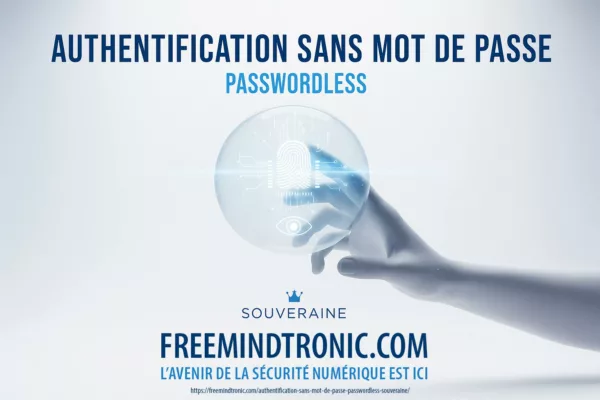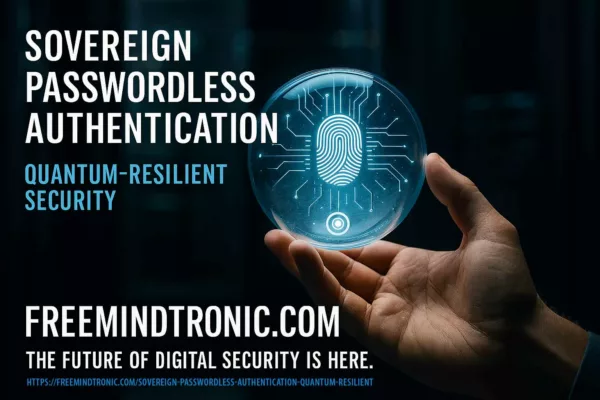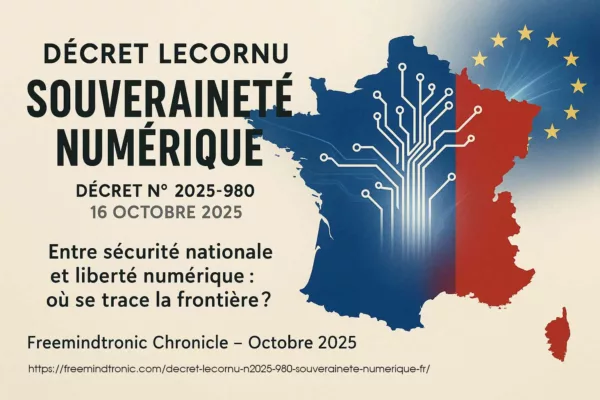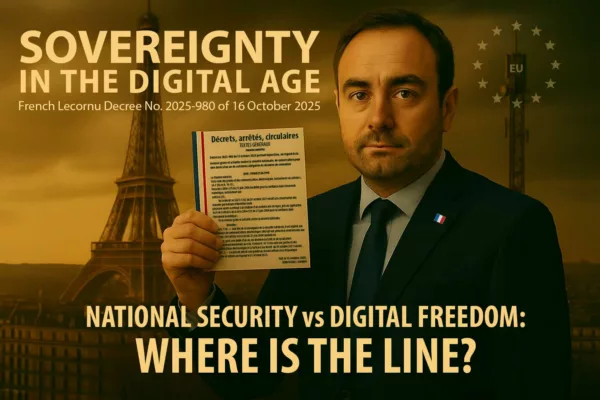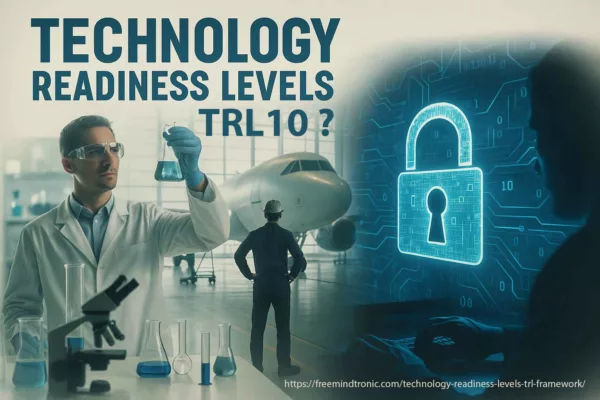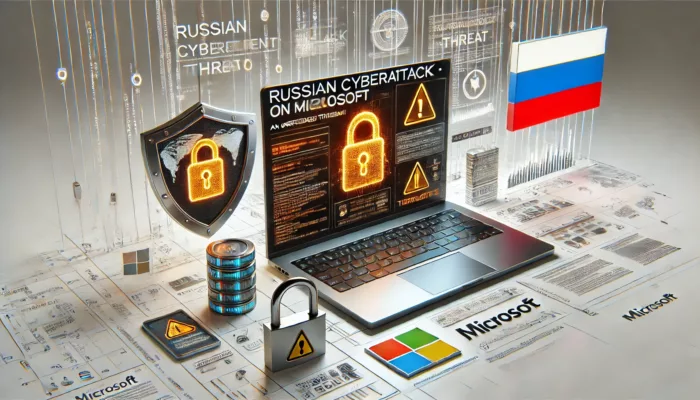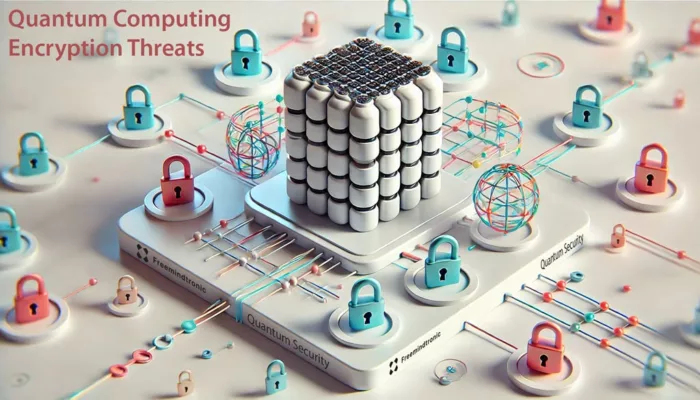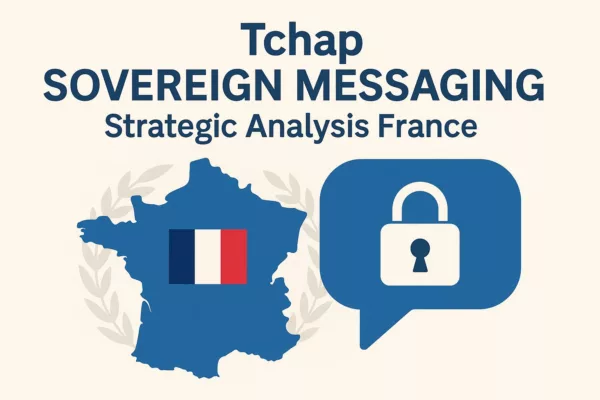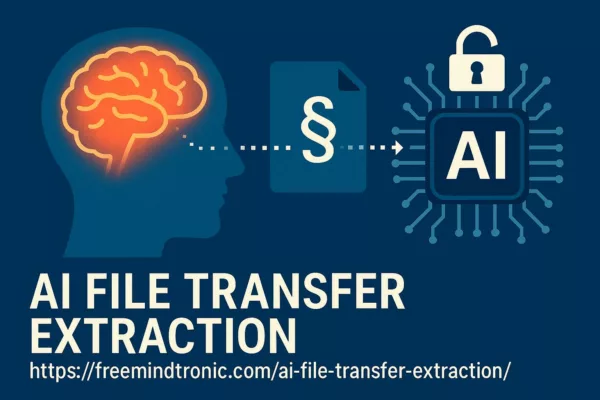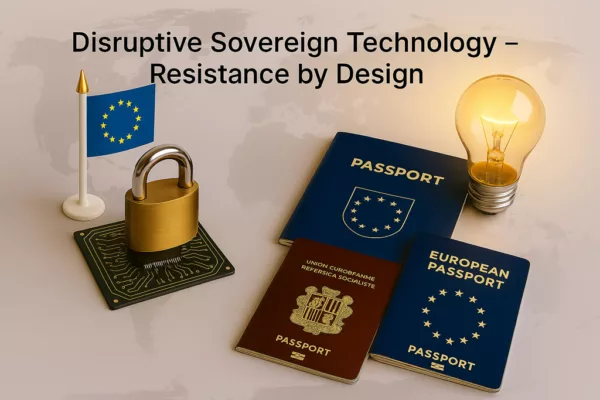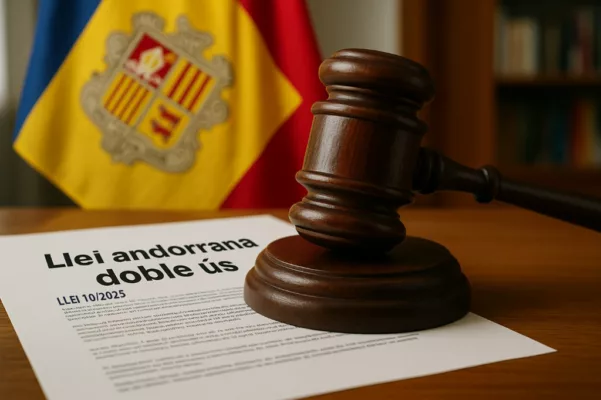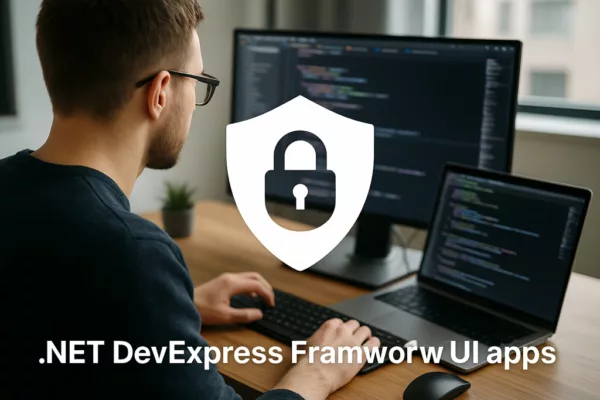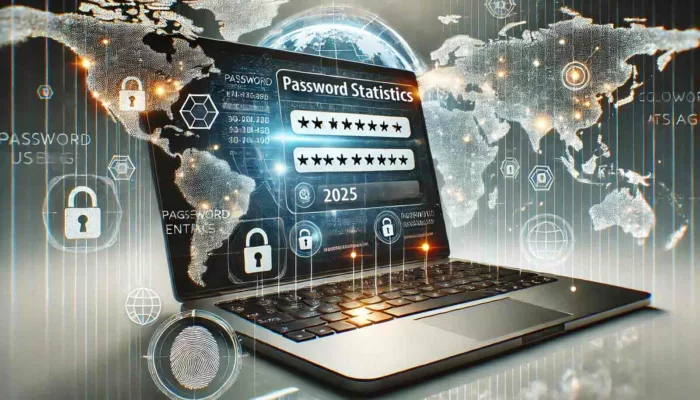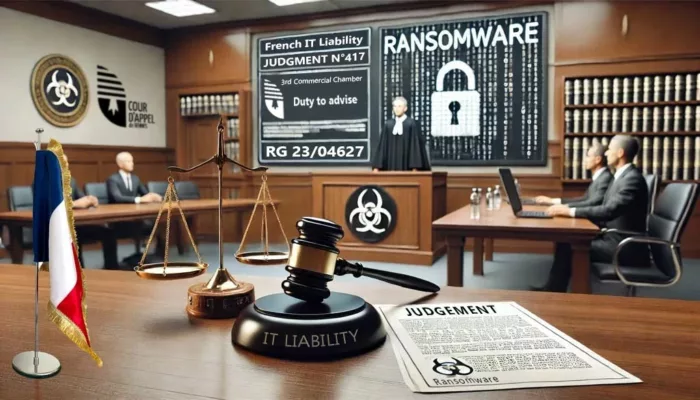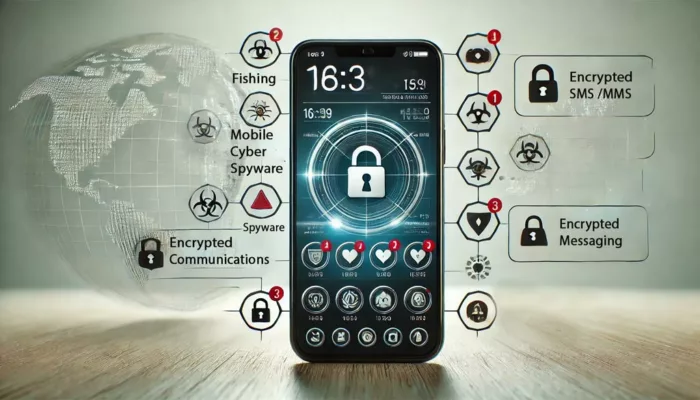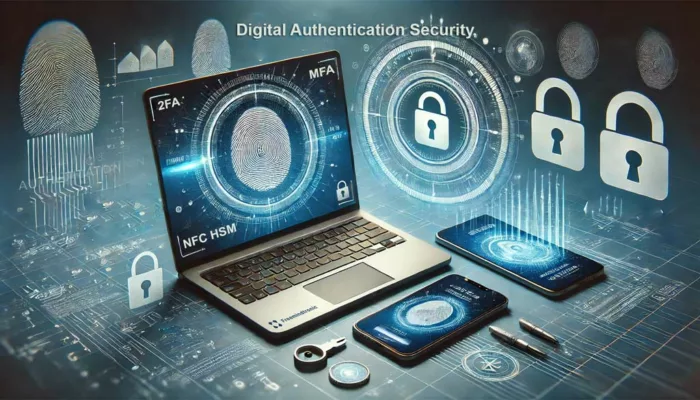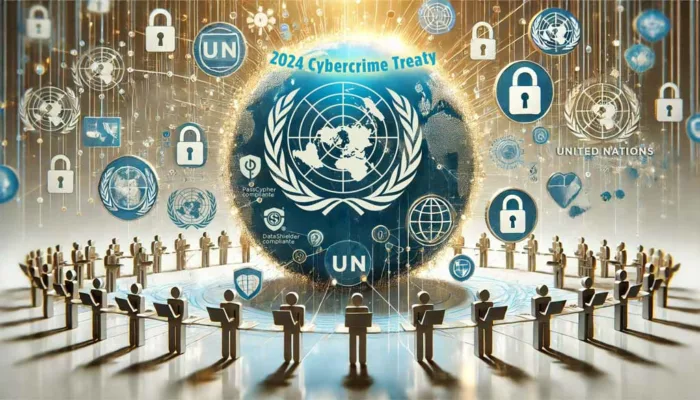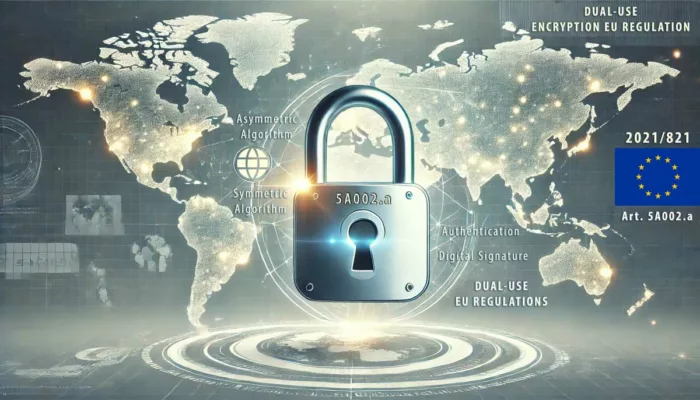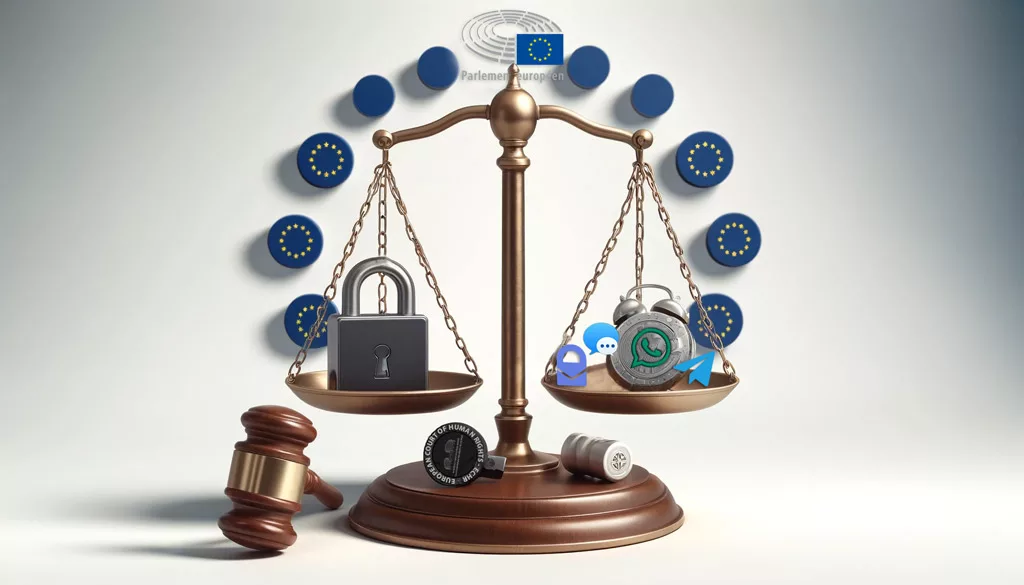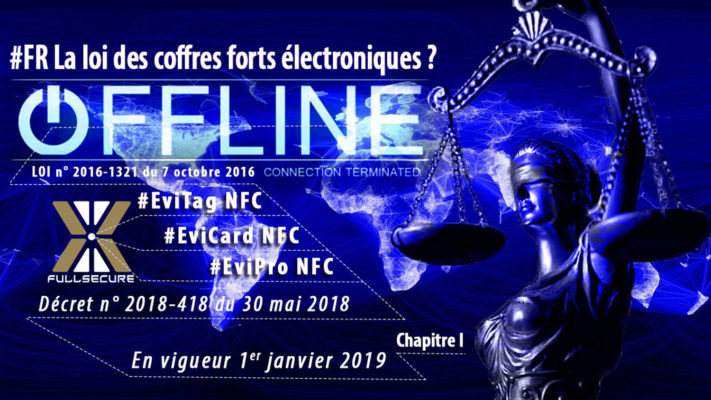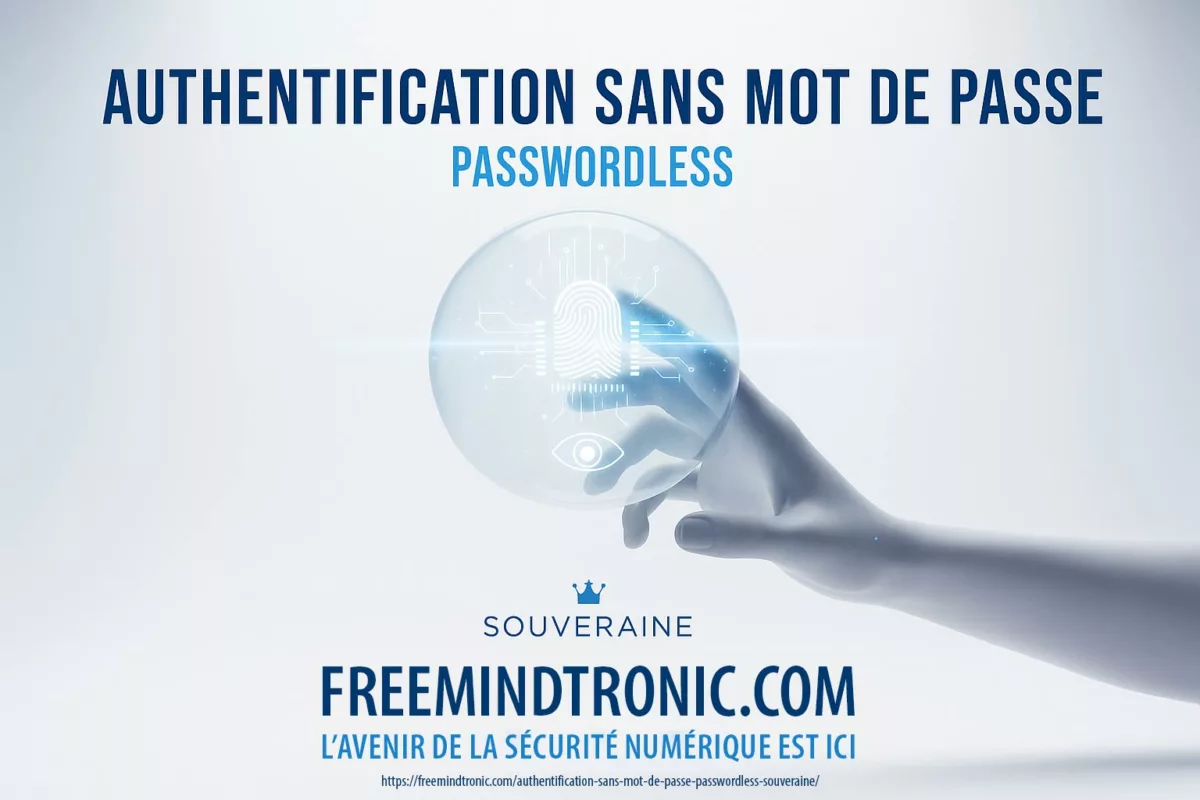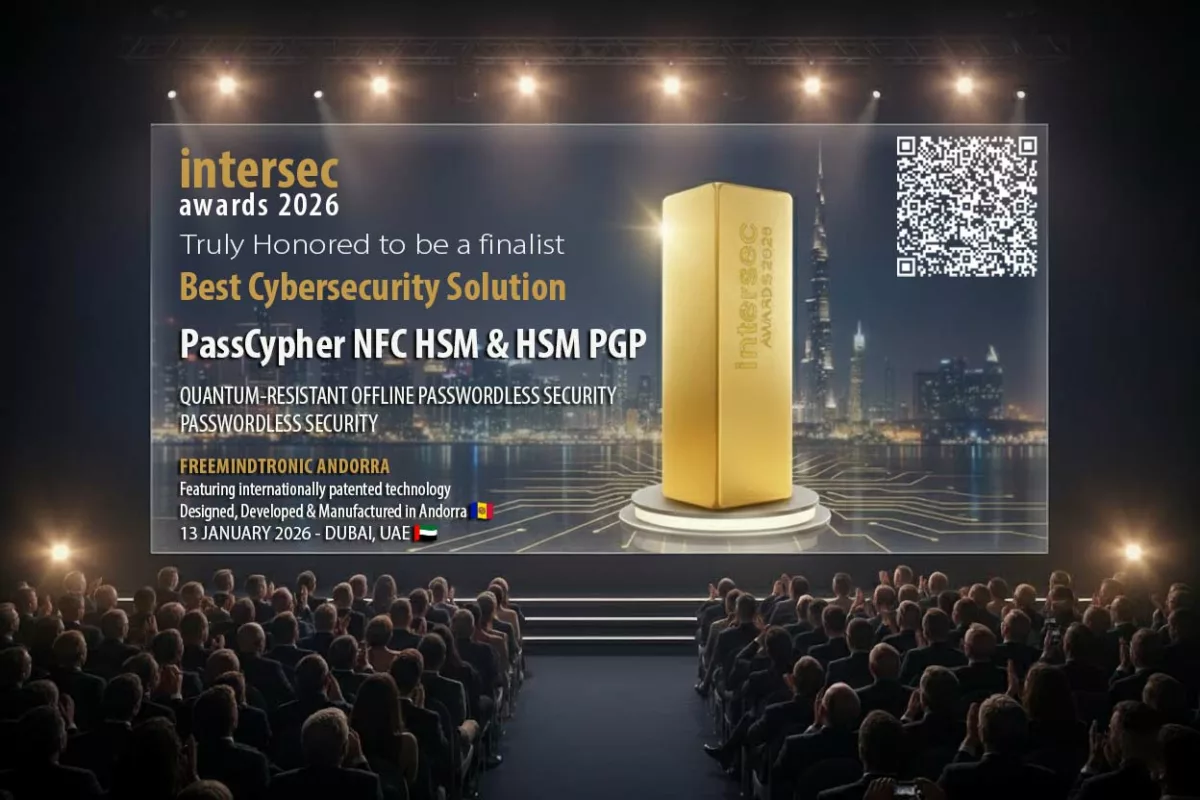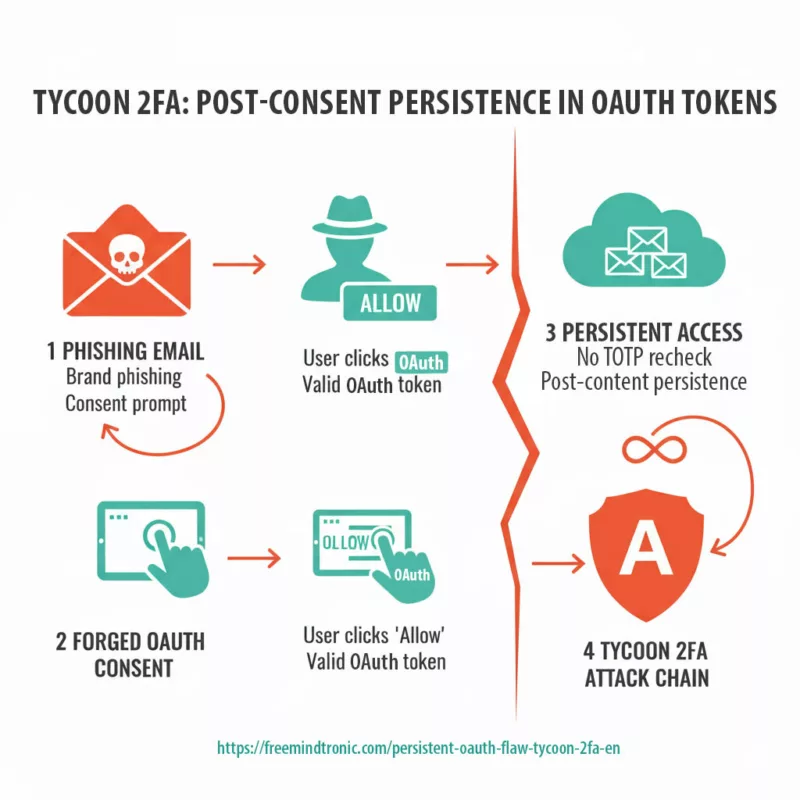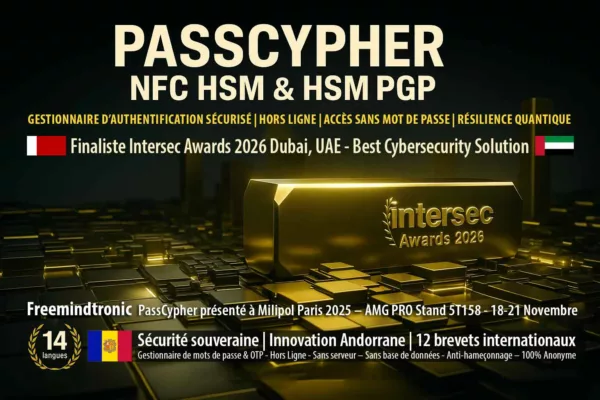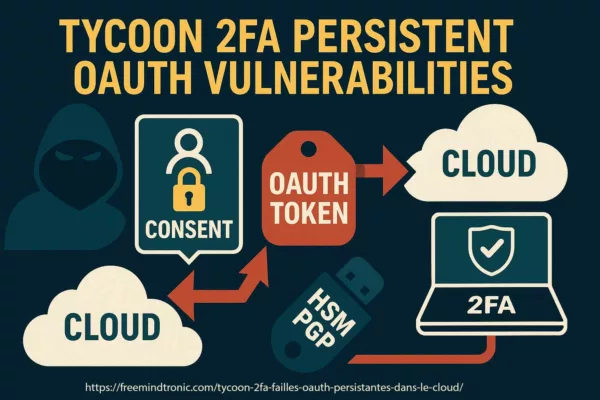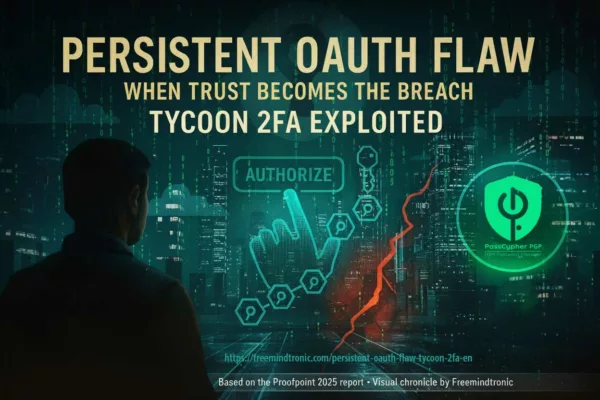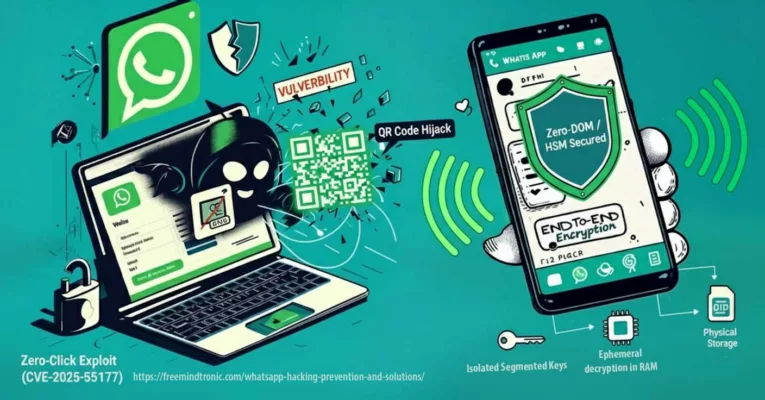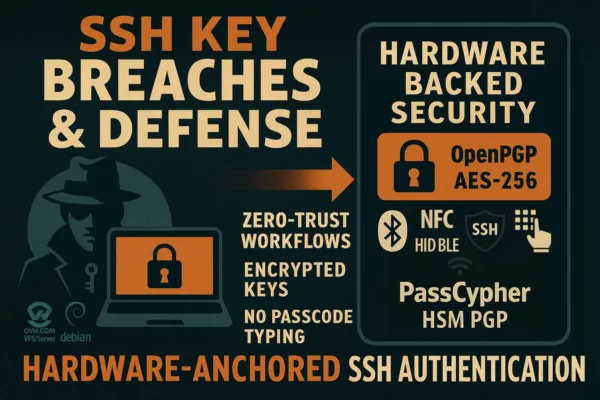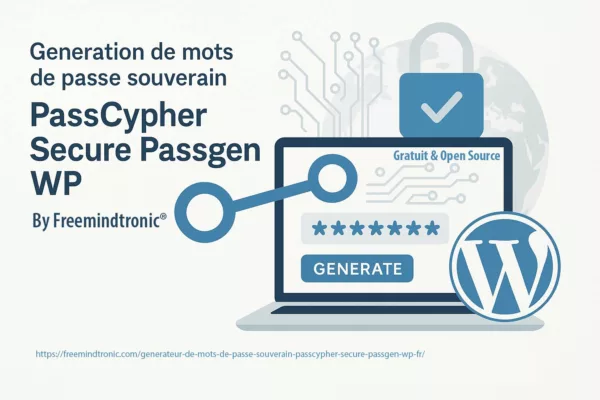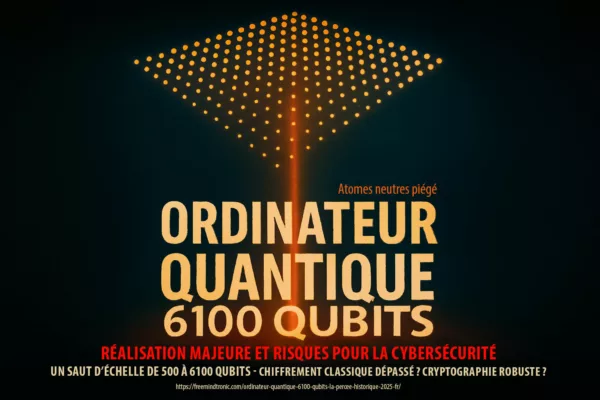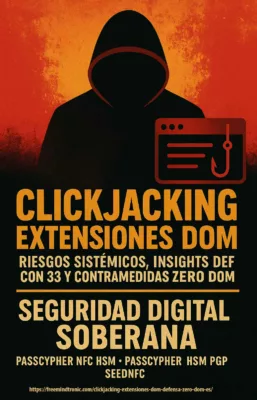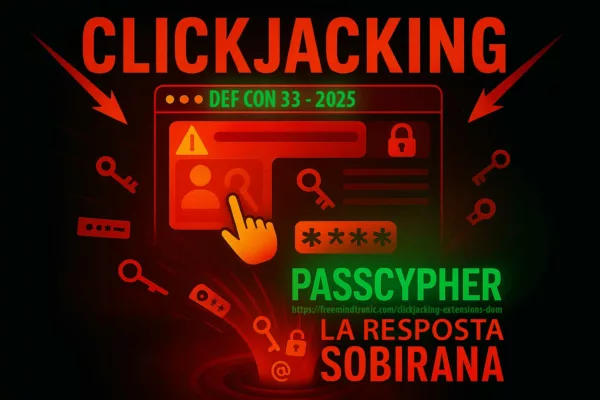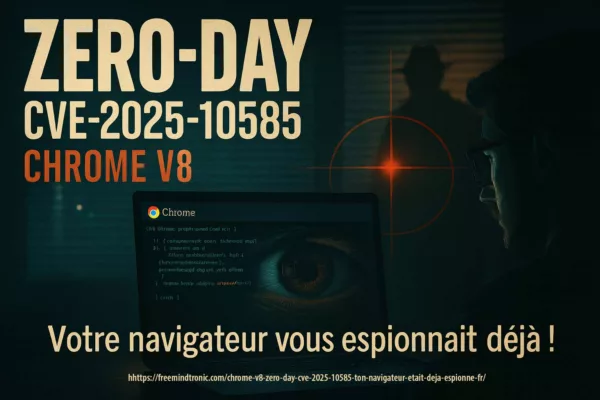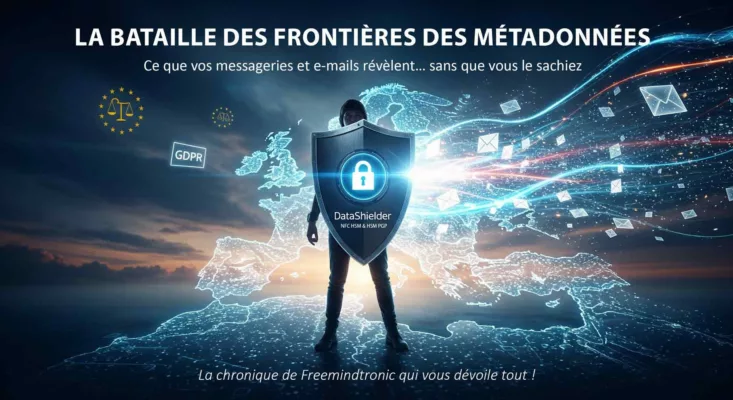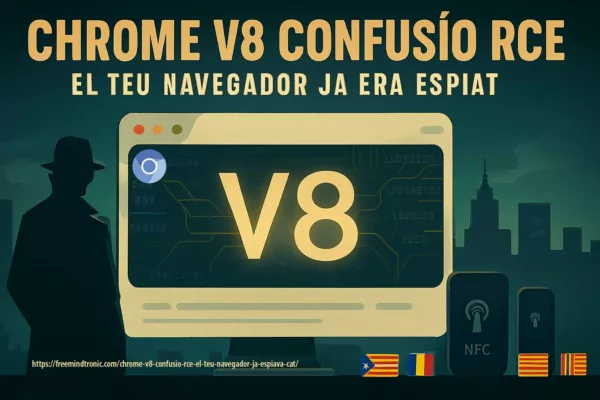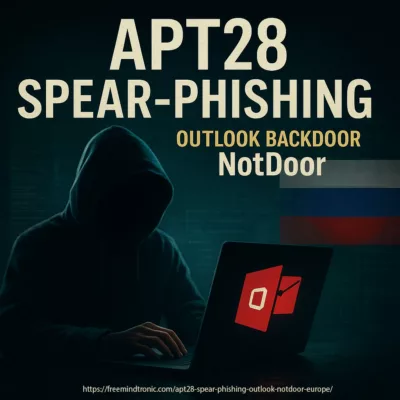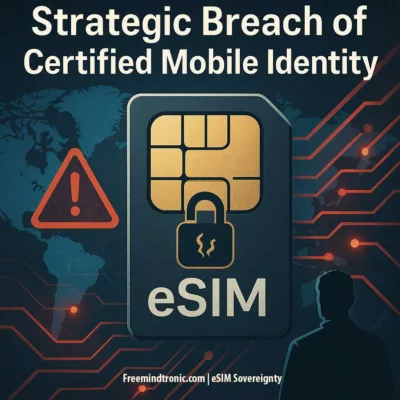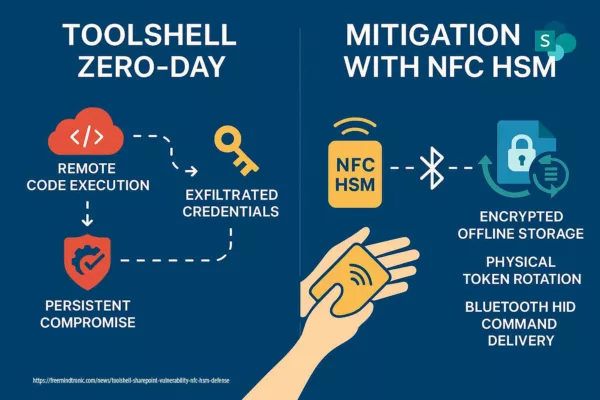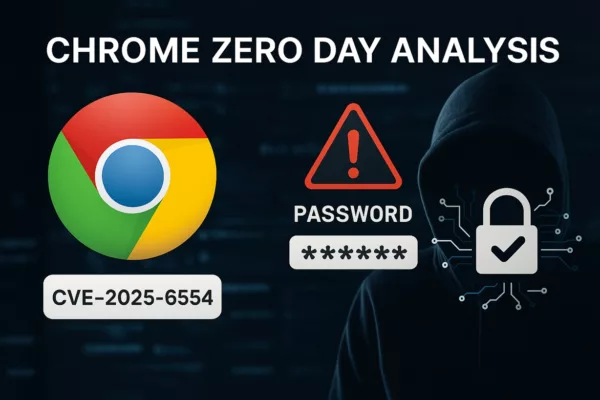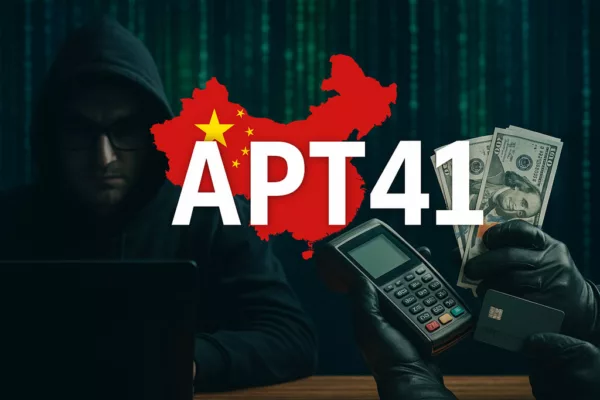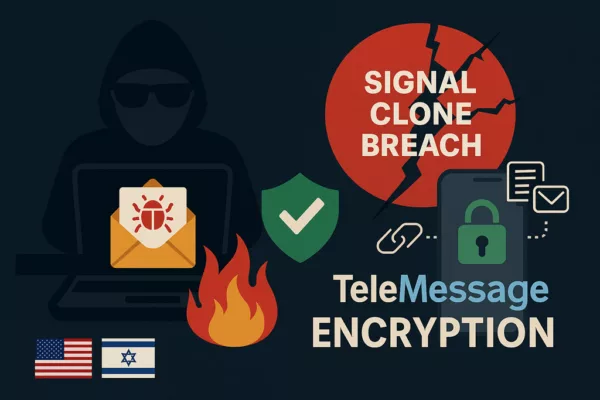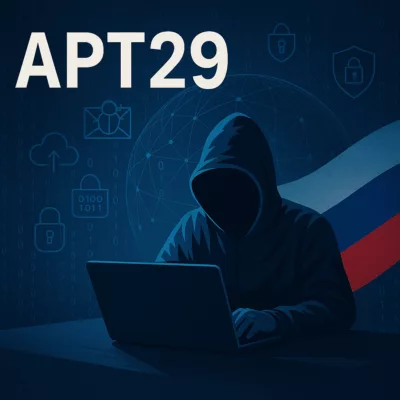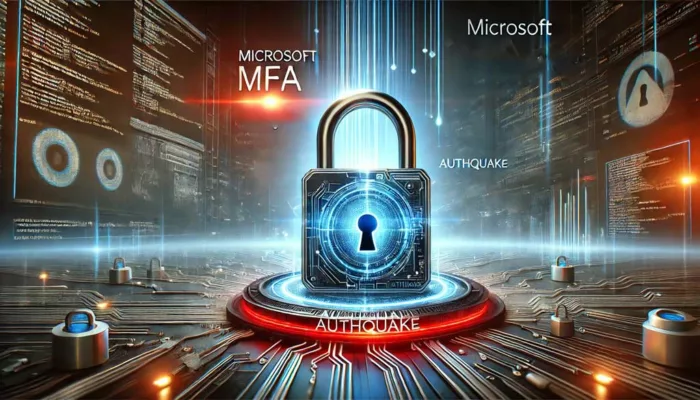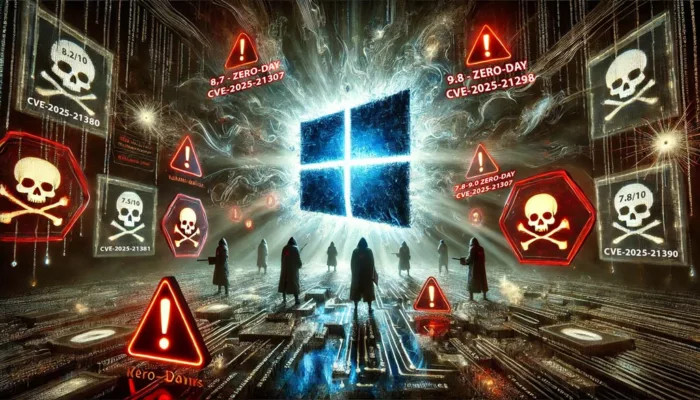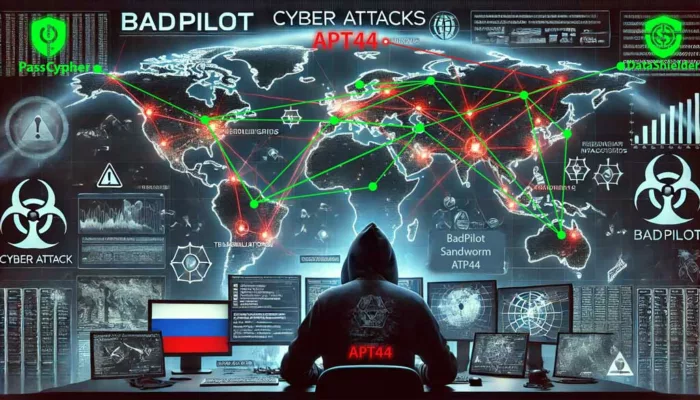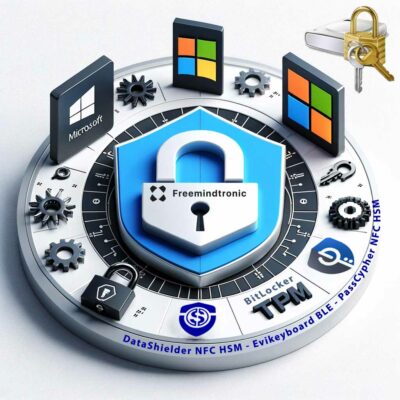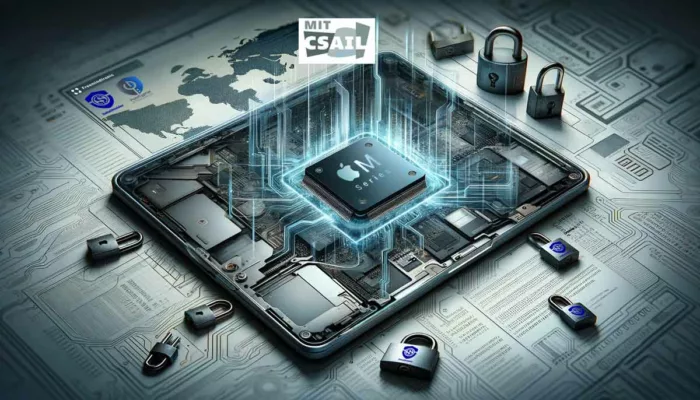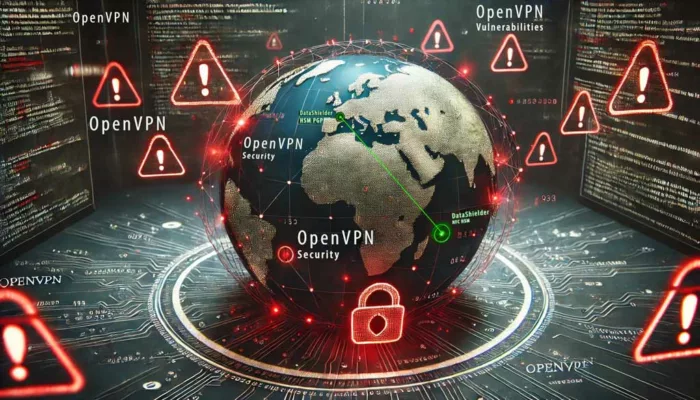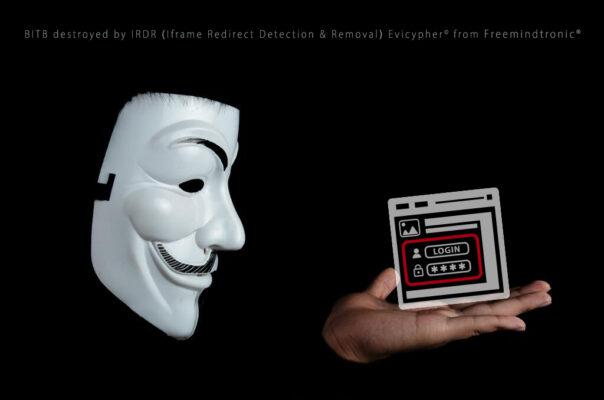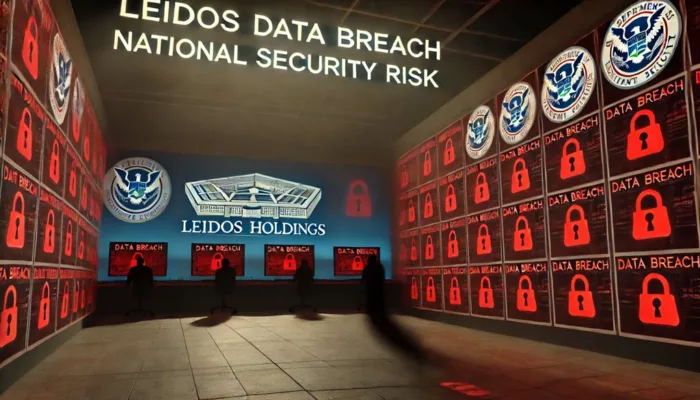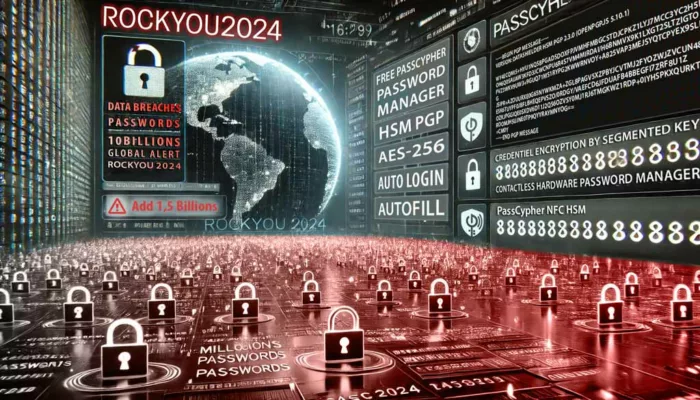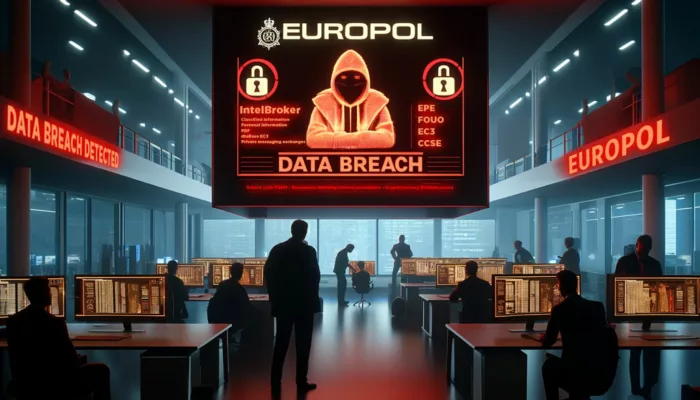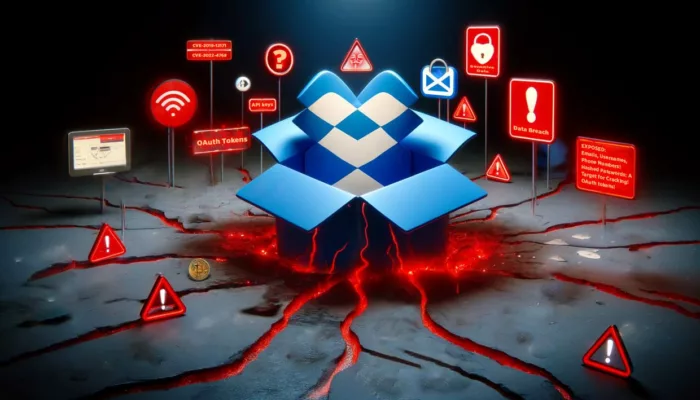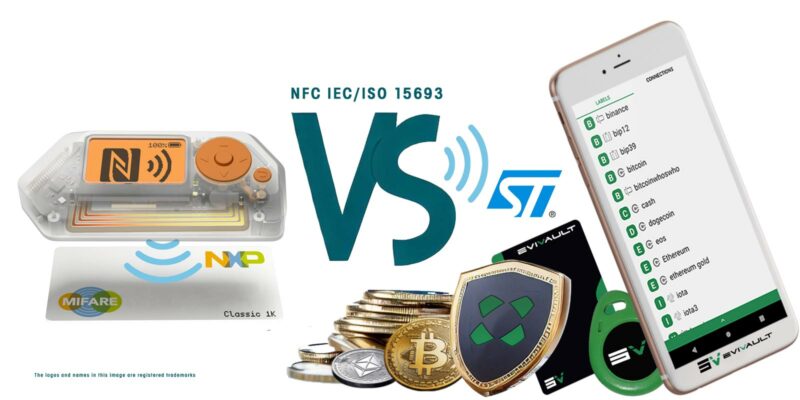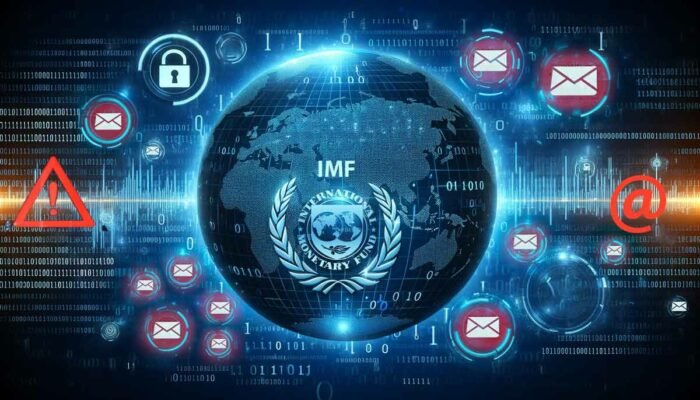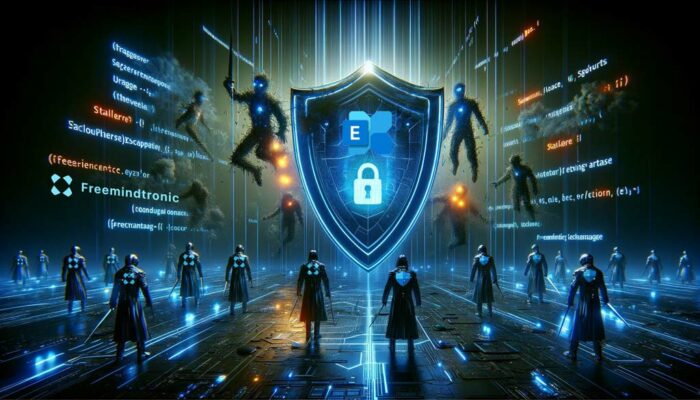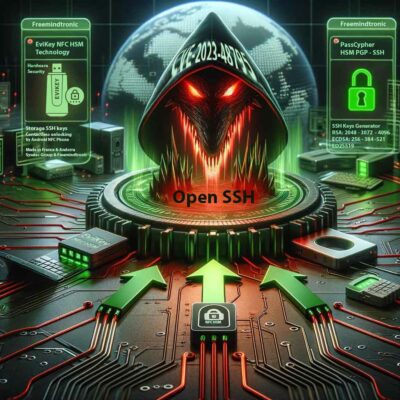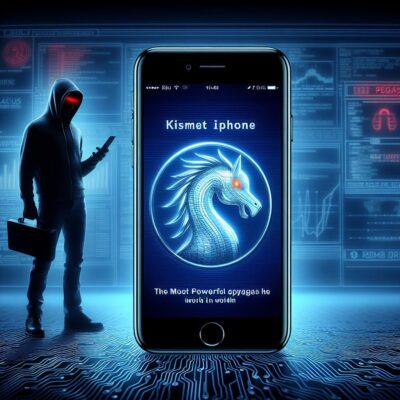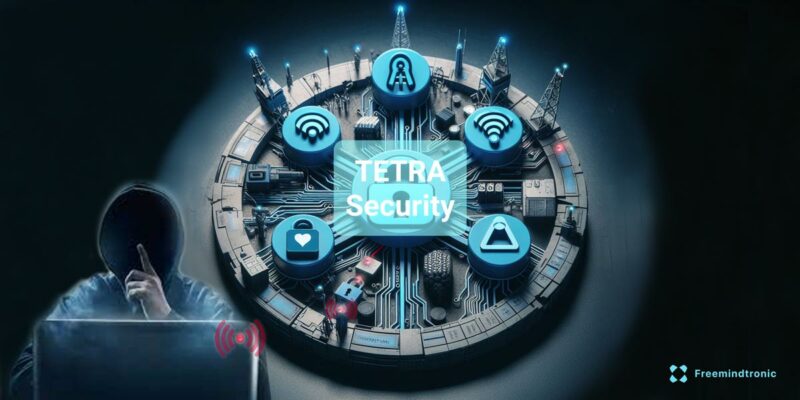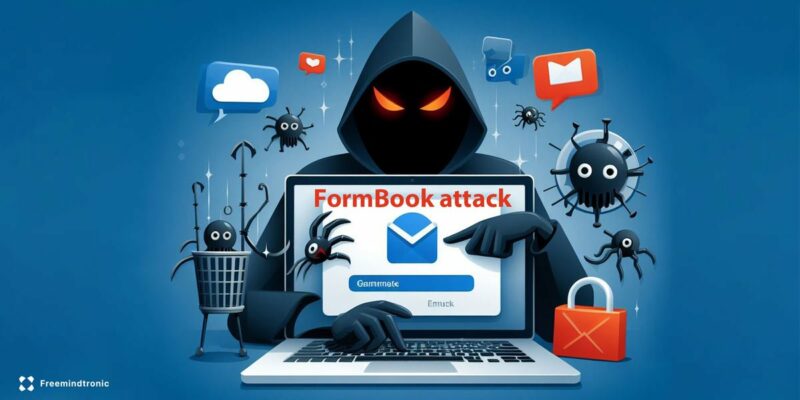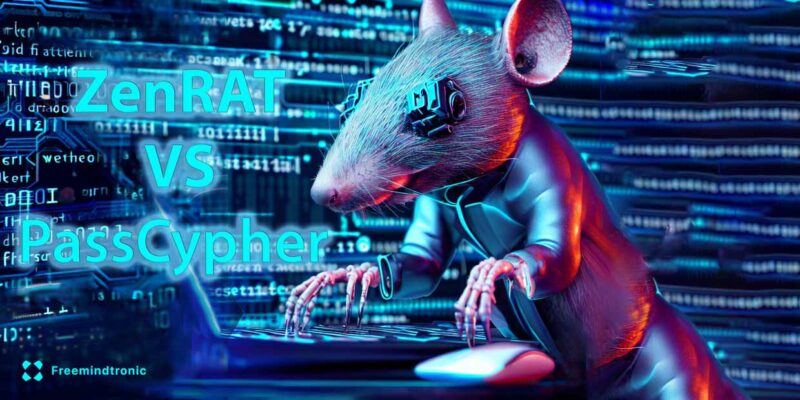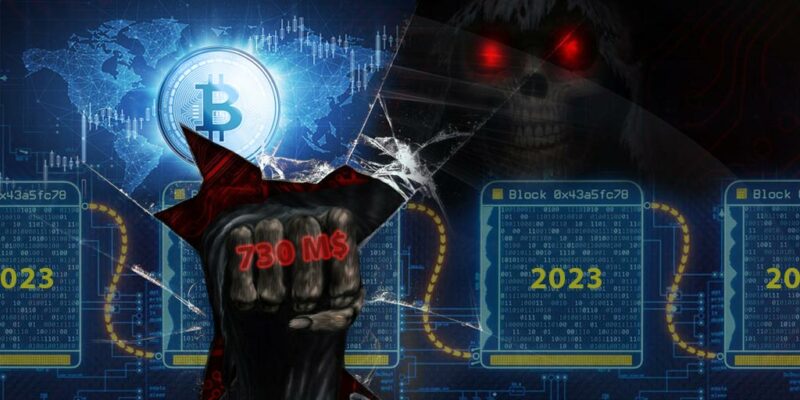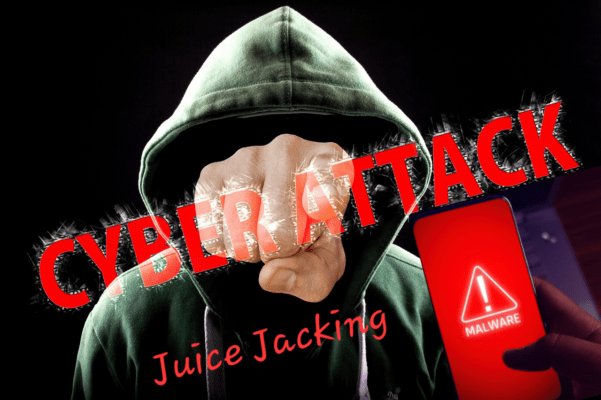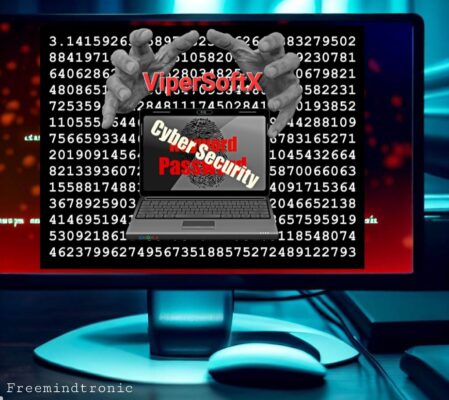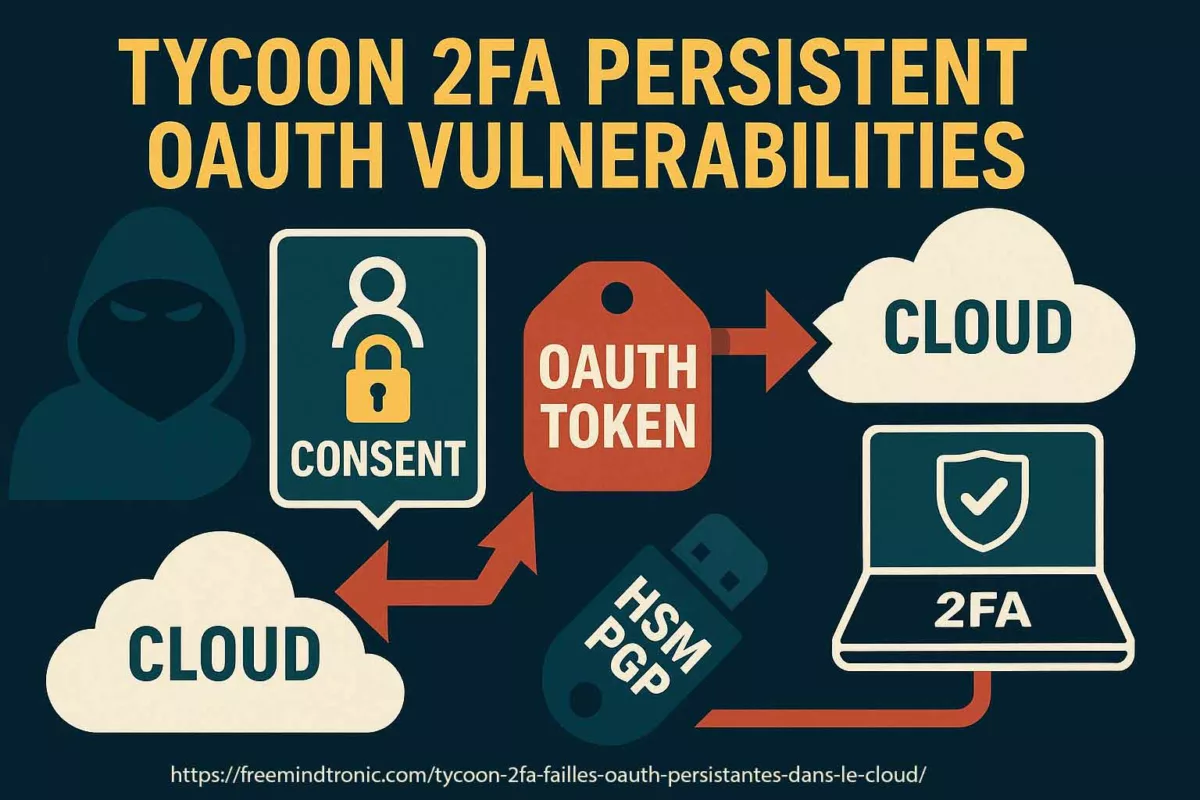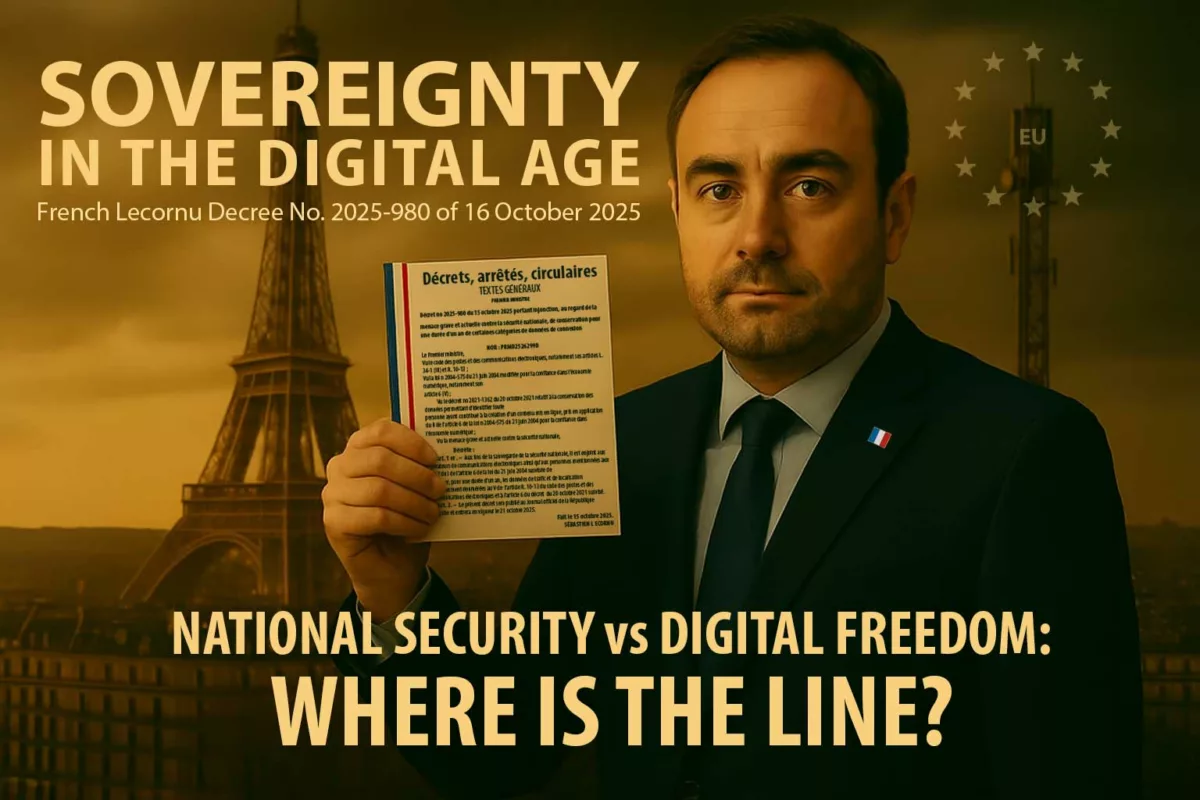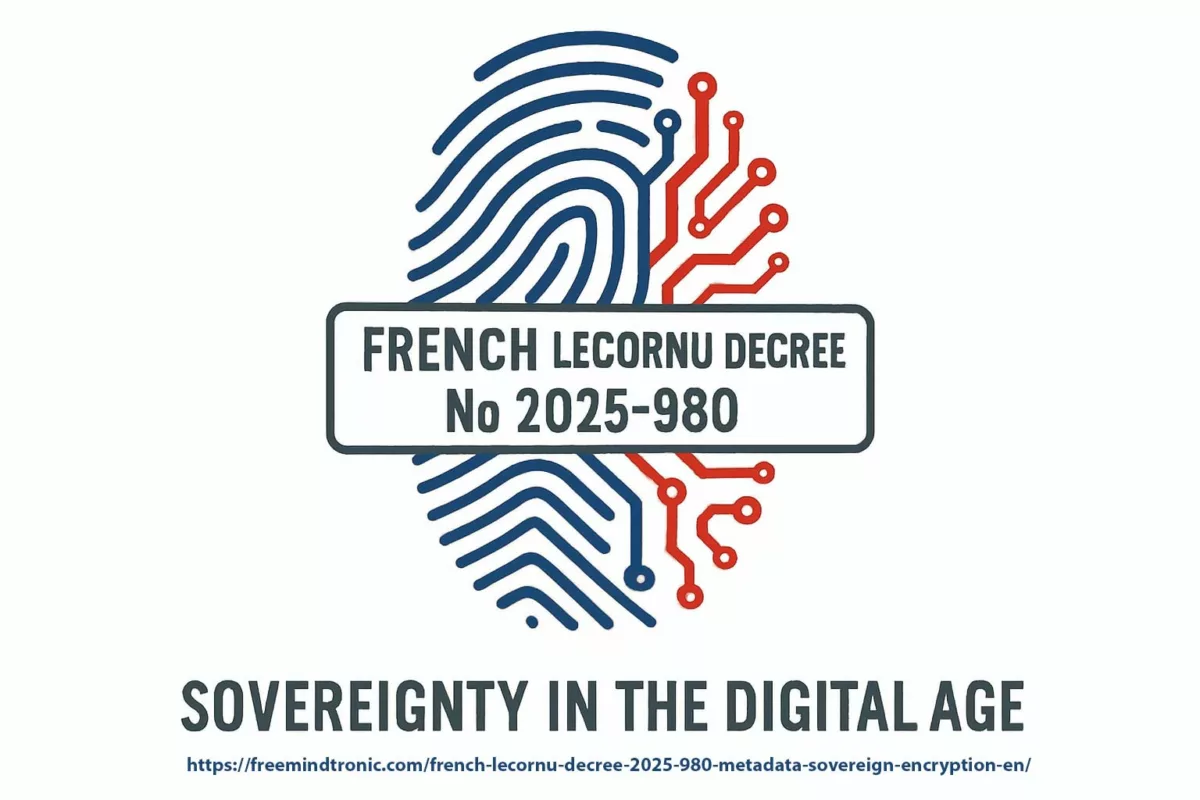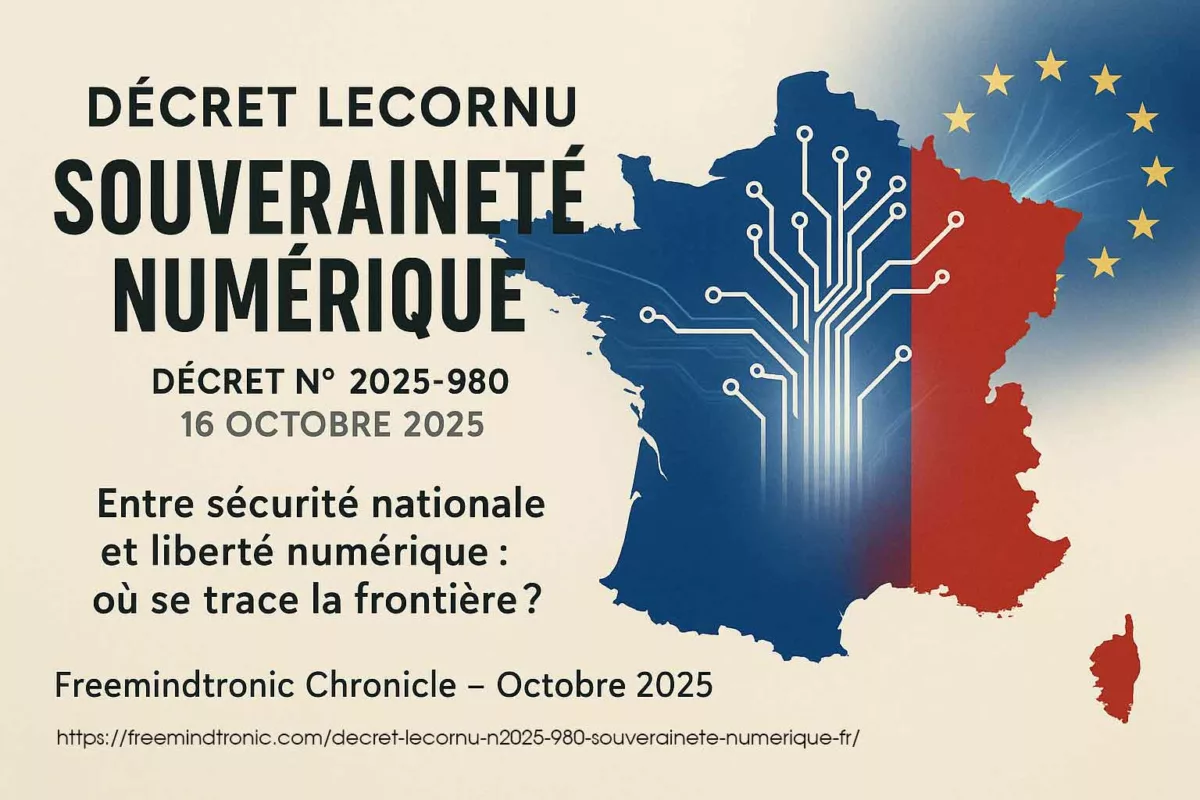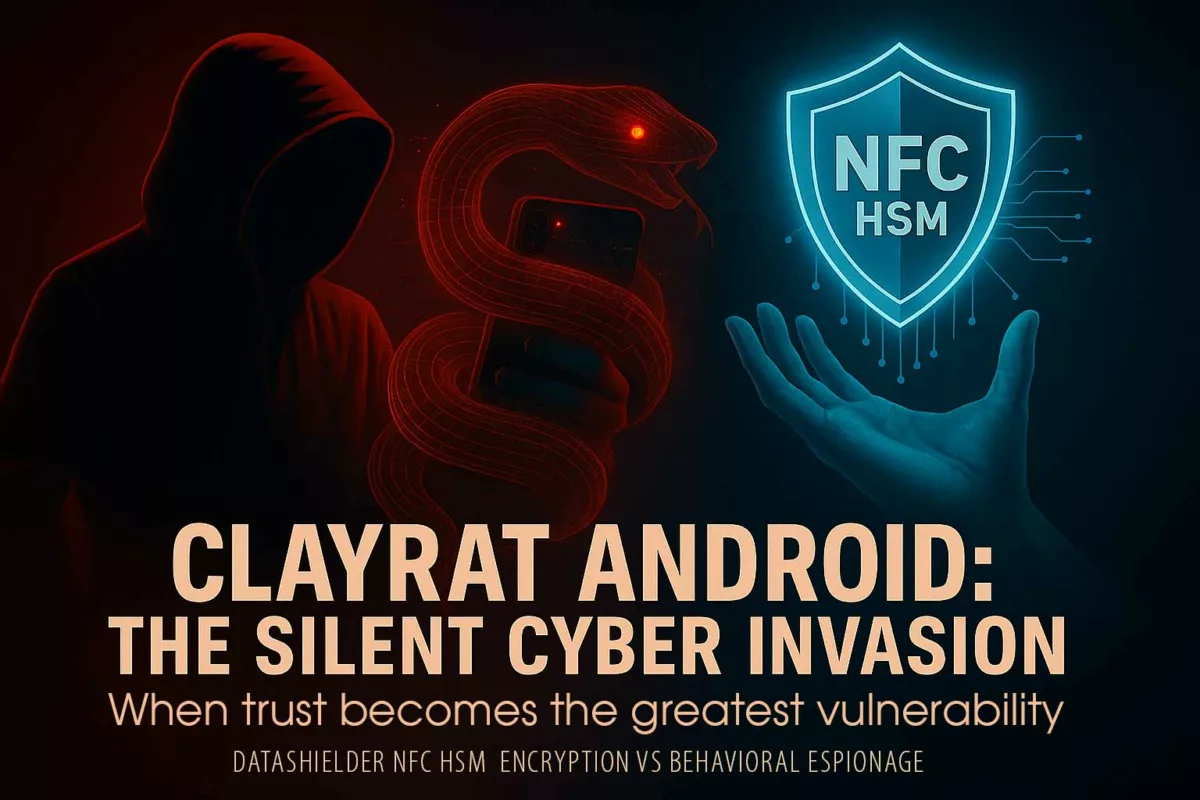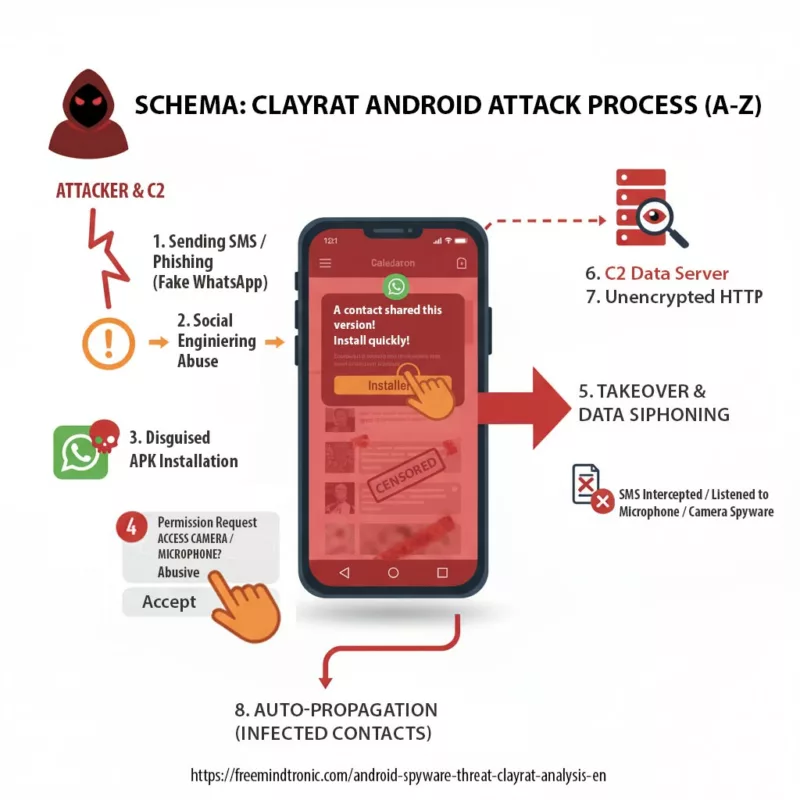مدير كلمات المرور المقاوم للكم 2026 (QRPM) — مرشح لجائزة أفضل حل للأمن السيبراني من PassCypher (باسسايفر) يضع معيارًا جديدًا للأمن السيادي غير المتصل بالإنترنت.
تم اختياره ضمن المتأهلين النهائيين لجائزة أفضل حل للأمن السيبراني في معرض إنترسيك دبي، إذ يعمل بالكامل داخل الذاكرة المتطايرة (RAM فقط) — بلا سحابة، بلا خوادم — لحماية الهويات والأسرار حسب التصميم.
بصفته مدير كلمات مرور غير متصل بالإنترنت، يقدم PassCypher تشفيرًا محليًا يعتمد على مفاتيح PGP مقسمة وخوارزمية AES-256-CBC لعمليات معزولة ومقاومة للهجمات.
وعلى عكس أي مدير كلمات مرور تقليدي، يتيح إثبات الملكية دون كلمات مرور (Passwordless) عبر المتصفحات والأنظمة المختلفة بقدرة توافقية عالمية.
وقد تم تأكيد هذا الاعتراف الدولي رسميًا عبر قائمة المتأهلين لجوائز إنترسيك 2026.
تتوجه شركة Freemindtronic Andorra (فريميندترونيك أندورا) بجزيل الشكر لفريق إنترسيك دبي وللجنة التحكيم الدولية على هذا التقدير.
ملخص سريع — منظومة سيادية بدون كلمات مرور (QRPM)
قراءة سريعة (≈ 4 دقائق):
ترشيح فريميندترونيك أندورا ضمن المتأهلين النهائيين لجوائز إنترسيك 2026 عن فئة أفضل حل للأمن السيبراني يؤكد على اكتمال منظومة سيادية متكاملة قائمة على تقنيات PassCypher HSM PGP وPassCypher NFC HSM.
تم تصميم هذه المنظومة استنادًا إلى براءات اختراع فرنسية الأصل لتعمل بالكامل داخل الذاكرة المتطايرة (RAM-only) وتتيح المصادقة بدون كلمات مرور دون الحاجة إلى FIDO أو مزامنة أو تخزين دائم.
يُقدِّم PassCypher، كمدير كلمات مرور سيادي غير متصل، تشفيرًا مقسمًا باستخدام PGP + AES-256-CBC لأمن مقاوم للحوسبة الكمّية، مع ترجمة مدمجة إلى 14 لغة للاستخدام في البيئات المعزولة.
اكتشف البنية الكاملة في صفحة مدير كلمات المرور السيادي غير المتصل.
⚙️ نموذج سيادي فعّال
تعمل وحدتا PassCypher HSM PGP وPassCypher NFC HSM كـ «وحدات ثقة فيزيائية» حقيقية، تُنفّذ جميع العمليات الحساسة محليًا — التشفير، التوقيع، فك التشفير، والمصادقة — دون خوادم أو سحابة أو وسطاء.
يعتمد هذا النموذج على مبدأ إثبات الملكية الفعلية والتشفير المدمج، مبتعدًا عن نماذج FIDO أو الحلول السحابية المركزية.
لماذا يُعتبر PassCypher مدير كلمات مرور سيادي غير متصل؟
تعمل وحدات PassCypher كمنظومات ثقة فيزيائية مستقلة؛ جميع عمليات التشفير (PGP، التوقيع، المصادقة) تُنفّذ محليًا، بدون خادم أو سحابة.
ويعتمد النموذج على إثبات الملكية والتشفير المدمج، لا على وسطاء الهوية المركزيين.
الانتشار العالمي
يضع هذا التميّز فريميندترونيك أندورا ضمن أبرز الحلول السيبرانية العالمية، ويؤكد دورها الريادي في الحماية السيادية غير المتصلة، جامعًا بين الهندسة الفرنسية والابتكار الأندوري والاعتراف الإماراتي في أكبر معرض عالمي للأمن والمرونة الرقمية.
المصادقة بدون كلمات مرور وبدون FIDO — نموذج سيادي غير متصل (QRPM)
يوفر PassCypher وصولًا بدون كلمات مرور دون الحاجة إلى FIDO/WebAuthn أو اتحاد الهويات.
تتم عملية التحقق محليًا (إثبات الملكية الفعلية) بشكل كامل دون خوادم أو سحابة أو تخزين دائم — وهي ركيزة أساسية في عقيدة مدير كلمات المرور المقاوم للكم 2026.
- إثبات الملكية — عبر NFC/HID أو السياق المحلي، دون جهات تحقق خارجية.
- التشفير المحلي — باستخدام PGP مقسم وAES-256-CBC داخل الذاكرة المتطايرة (RAM فقط).
- توافقية عالمية — يعمل عبر المتصفحات والأنظمة دون مفاتيح مرور أو مزامنة.
إعدادات القراءة
مدة قراءة الملخص السريع: ≈ 4 دقائق
مدة قراءة الملخص المتقدم: ≈ 6 دقائق
مدة قراءة المقال الكامل: ≈ 35 دقيقة
تاريخ النشر: 30 أكتوبر 2025
آخر تحديث: 31 أكتوبر 2025
مستوى التعقيد: خبير — علم التشفير والسيادة
الكثافة التقنية: ≈ 79%
اللغات المتاحة: FR · CAT · EN · ES · AR
التركيز: تحليل سيادي — فريميندترونيك أندورا، إنترسيك دبي، الأمن غير المتصل
ترتيب القراءة: الملخص → العقيدة → البنية → التأثيرات → الانتشار الدولي
الوصولية: متوافق مع قارئات الشاشة — وسوم وهيكلية منظمة
النوع التحريري: مقال جوائز خاص — مرشح لأفضل حل للأمن السيبراني
مستوى الأهمية: 8.1 / 10 — دولي، تشفيري، استراتيجي
عن المؤلف: جاك غاسكويل، مخترع ومؤسس فريميندترونيك أندورا، خبير في بنى HSM والسيادة التشفيرية والأمن غير المتصل.
كُتب هذا المحتوى وفقًا لإعلان الشفافية في استخدام الذكاء الاصطناعي الصادر عن فريميندترونيك أندورا — FM-AI-2025-11-SMD5
المراجع الرسمية ووسائل الإعلام
المحلية السيادية (دون اتصال)
كل من PassCypher HSM PGP وPassCypher NFC HSM مترجمان بشكل مدمج إلى أكثر من 13 لغة، بما في ذلك العربية.
تُخزَّن الترجمات محليًا على الجهاز دون أي استدعاء لخدمات ترجمة عبر الإنترنت، ما يضمن السرية والتوفر في البيئات المعزولة (Air-Gap).
⮞ تمهيد — اعتراف دولي ومؤسسي
تتقدّم فريميندترونيك أندورا بخالص الشكر إلى لجنة التحكيم الدولية وإلى شركة Messe Frankfurt Middle East، المنظّمة لجائزة إنترسيك، على جودة التنظيم والدقة والانتشار العالمي لهذه المسابقة المكرّسة للأمن والسيادة والابتكار.
إن الحصول على هذا التقدير في دبي — في قلب الإمارات العربية المتحدة — يؤكد الاعتراف بابتكار أندوري ذي جذور أوروبية يُعد نموذجًا في المصادقة السيادية غير المتصلة والمقاومة للحوسبة الكمّية.
كما يعكس الالتزام المشترك بين أوروبا والعالم العربي في تعزيز البنى الرقمية القائمة على الثقة والحياد والمرونة التكنولوجية.
الملخص المتقدم — العقيدة والمدى الاستراتيجي للمنظومة السيادية غير المتصلة
إنترسيك 2026 — ترشيح PassCypher لأفضل حل للأمن السيبراني
يمثل اختيار PassCypher ضمن المتأهلين النهائيين لجائزة أفضل حل للأمن السيبراني في إنترسيك 2026 إنجازًا يتجاوز حدود التكنولوجيا ليجسد عقيدة سيادية متكاملة للأمن المقاوم للحوسبة الكمّية والخالي من كلمات المرور.
يُعد هذا الترشيح تاريخيًا: فهي المرة الأولى التي يتم فيها الاعتراف بحل أندوري، قائم على براءات اختراع فرنسية ويعمل دون أي اعتماد على الشبكات، كبديل عالمي موثوق للعمارة الرقمية المركزية للقوى التقنية الكبرى.
↪ الأبعاد الجيوسياسية والعقائدية
يمنح هذا الاعتراف لأندورا دورًا جديدًا: مختبرًا للحياد الرقمي داخل الفضاء الأوروبي الأوسع.
تقدّم فريميندترونيك نموذج ابتكار سيادي — أندوري في الحياد، فرنسي في الأصل، أوروبي في الرؤية.
ومن خلال فئة أفضل حل للأمن السيبراني، يرمز PassCypher إلى توازن استراتيجي بين الاستقلال التشفيري والتوافق المعياري الدولي.
الأمن عبر الذاكرة المتطايرة فقط — السيادة بدون كلمات مرور (QRPM)
↪ بنية غير متصلة قائمة على الذاكرة المؤقتة
ترتكز منظومة PassCypher على مبدأ فريد: جميع العمليات الحرجة — التخزين، الاشتقاق، المصادقة، إدارة المفاتيح — تُنفذ حصريًا داخل الذاكرة المتطايرة (RAM).
لا تُكتب أي بيانات أو تُزامَن أو تُخزَّن بشكل دائم.
يُزيل هذا النهج تلقائيًا كل نواقل الاعتراض أو التجسس أو اختراق ما بعد التنفيذ — حتى في مواجهة التهديدات الكمّية.
تجزئة مفاتيح PGP + AES-256-CBC لتشغيل آمن ومقاوم للكمّية
↪ التجزئة والسيادة على الأسرار
يُطبّق النظام مبدأ التجزئة الديناميكية للمفاتيح، مما يفصل كل سر عن سياقه التشغيلي.
كل مثيل من PassCypher يعمل كـ وحدة أمان مصغّرة (micro-HSM) مستقلة — تعزل الهويات، وتتحقق محليًا من الحقوق، وتدمّر البيانات فور استخدامها.
إنه نموذج الحذف حسب التصميم، بخلاف نماذج FIDO أو SaaS التي تقوم على الاستمرارية والتفويض وتشكل نقاط ضعف بنيوية.
↪ اعتراف رمزي بالعقيدة السيادية
إدراج فريميندترونيك أندورا ضمن قائمة المرشحين لعام 2026 يرفع مفهوم السيادة التكنولوجية إلى مستوى ركيزة للابتكار الدولي.
وفي مشهدٍ يهيمن عليه الاعتماد على السحابة، يبرهن PassCypher أن الانفصال المُتحكم به يمكن أن يكون أصلًا استراتيجيًا، يضمن الاستقلال التنظيمي، التوافق مع GDPR/NIS2، والمرونة ضد الترابط الصناعي الزائد.
⮞ اعتراف دولي موسّع
امتدّ تأثير PassCypher عالميًا ليشمل قطاع الدفاع والأمن.
سيتم عرض الحل من قبل شركة AMG PRO خلال معرض MILIPOL 2025 — الجناح 5T158 — بصفته الشريك الفرنسي الرسمي لـ فريميندترونيك أندورا في تقنيات الاستخدام المزدوج المدني والعسكري.
هذا الحضور يؤكد مكانة PassCypher كحل مرجعي للأمن السيبراني السيادي الموجّه لقطاعات الدفاع والصناعات الحساسة.
⮞ في سطور مختصرة
- البنية: أمان يعتمد على الذاكرة المتطايرة فقط (RAM-only) باستخدام مفاتيح PGP مجزأة + AES-256-CBC.
- النموذج: مصادقة بدون كلمات مرور دون FIDO، بدون خوادم أو سحابة.
- التموضع: مدير كلمات مرور سيادي غير متصل مخصص للقطاعات الحساسة والمنفصلة عن الشبكة.
- الاعتراف: مرشح جائزة إنترسيك 2026 لأفضل حل للأمن السيبراني — أمن مقاوم للكم حسب التصميم.
☰ القائمة السريعة
- 🔝 العودة إلى الأعلى
- ملخص سريع — منظومة سيادية غير متصلة بدون كلمات مرور (QRPM)
- ملخص موسّع — العقيدة والنطاق الاستراتيجي
- الوقائع — السيادة المُثبتة في دبي
- السياق الرسمي — جوائز إنترسيك ٢٠٢٦
- ابتكار PassCypher — السيادة والأمان والاستقلال
- ابتكار أندوري بجذور أوروبية
- سابقة تاريخية — أول ترشيح لحل بدون كلمات مرور في الإمارات
- سيادة مؤكدة — نحو نموذج مستقل
- الانتشار الدولي — نحو نموذج سيادي عالمي
- السيادة الموحّدة — نحو معيار دولي
- 🛒 المتجر — أجهزة PassCypher السيادية
- الأسئلة الشائعة
المقالات المعروضة أعلاه ↑ تنتمي إلى القسم التحريري نفسه جوائز التميّز — الأمن الرقمي.
وهي تُكمل التحليل حول السيادة والحياد الأندوري وإدارة الأسرار غير المتصلة،
المرتبطة مباشرةً بتكريم PassCypher في معرض إنترسيك دبي.
السرد المركزي — السيادة المؤكدة في دبي (أمن بدون اتصال)
يُعد اختيار فريميندترونيك أندورا رسميًا ضمن المتأهلين لجوائز إنترسيك 2026 لأفضل حل للأمن السيبراني تحولًا تاريخيًا.
فهي المرة الأولى التي يُعترف فيها بحل أندوري قائم على براءات اختراع فرنسية ويعمل باستقلال تام عن الشبكات كبديل موثوق عالميًا للأنظمة السحابية المركزية.
↪ المرونة الخوارزمية السيادية (مقاومة للكم حسب التصميم)
بدلاً من الاعتماد على خوارزميات ما بعد الكم التجريبية، يوفر PassCypher مرونة هيكلية عبر تجزئة ديناميكية لمفاتيح PGP مع AES-256-CBC تُنفذ بالكامل داخل الذاكرة المتطايرة (RAM).
تُقسّم المفاتيح إلى شرائح مستقلة مؤقتة، مما يقطع سبل الاستغلال — بما في ذلك تلك المرتبطة بخوارزميات Grover وShor.
إنه ليس PQC بل نموذج تشغيلي مقاوم للكم بطبيعته.
↪ الابتكار يلتقي بالاستقلال
يُثبت الترشيح عقيدة المرونة عبر الانفصال: حماية الأسرار الرقمية دون خادم أو سحابة أو أثر.
تظل المصادقة وإدارة الأسرار مستقلة تمامًا — مصادقة بدون كلمات مرور دون FIDO أو WebAuthn أو وسطاء هوية — بحيث يحتفظ المستخدم بالتحكم الفعلي بمفاتيحه وهويته وحدود ثقته.
↪ جوائز إنترسيك 2026 — المنظومة في دائرة الضوء
تنظم Messe Frankfurt Middle East جائزة إنترسيك لتسليط الضوء على الابتكارات الأمنية التي توازن بين الأداء والامتثال والاستقلالية.
يؤكد حضور فريميندترونيك أندورا البعد الدولي لعقيدة الأمن السيادي غير المتصل المطورة في دولة محايدة كبديل موثوق للمعايير العالمية.
⮞ أبرز ملامح إنترسيك 2026
- الحدث: جوائز إنترسيك 2026 — فندق كونراد دبي
- الفئة: أفضل حل للأمن السيبراني
- المرشح: فريميندترونيك أندورا — منظومة PassCypher
- الابتكار: إدارة سيادية غير متصلة للأسرار الرقمية (RAM-only، Air-Gapped)
- الأصل: براءات اختراع فرنسية ذات نطاق دولي
- البنية: ذاكرة متطايرة · تجزئة مفاتيح · دون اعتماد على السحابة
- القيمة العقائدية: السيادة التقنية، الحياد الجيوسياسي، الاستقلال التشفيري
- الاعتماد الرسمي: قائمة المتأهلين الرسمية لجوائز إنترسيك 2026
أبرز النقاط:
- أمن سيادي بدون كلمات مرور مع صفر سحابة / صفر خادم قائم على إثبات الملكية الفعلية.
- توافق عالمي عبر المتصفحات والأنظمة دون اعتماد بروتوكولي.
- مرونة هيكلية عبر تجزئة المفاتيح والذاكرة المتطايرة (RAM فقط).
السياق الرسمي — جوائز إنترسيك 2026 للأمن السيبراني المقاوم للكمّية
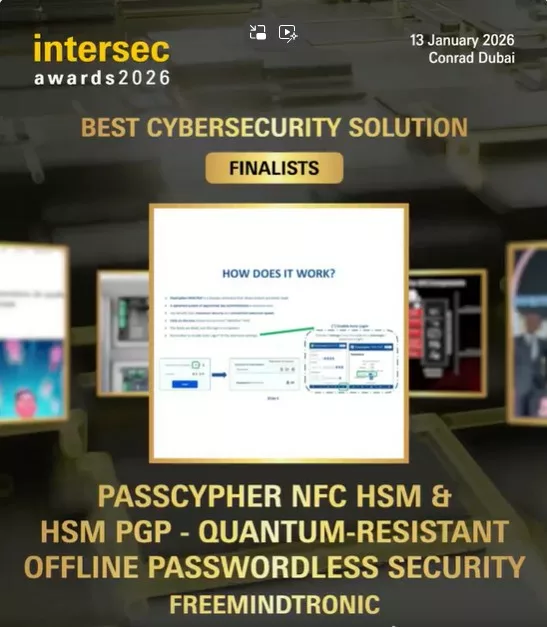
تُعقد النسخة الخامسة في 13 يناير 2026 بفندق كونراد دبي، لتكريم المبدعين عبر 17 فئة تشمل الأمن المادي، الأمن السيبراني، السلامة من الحرائق، وحماية البنى التحتية الحيوية.
في فئة أفضل حل للأمن السيبراني، تم اختيار خمسة فقط كمتأهلين نهائيين بعد عملية تقييم دقيقة أجرتها لجنة دولية من الخبراء والباحثين وممثلي المؤسسات الإماراتية.
للمقارنة، استقطبت نسخة جوائز إنترسيك 2025 ما مجموعه 1,412 ترشيحًا دوليًا موزعة على 15 فئة، مما يؤكد مدى انتشار الحدث عالميًا. المصدر الرسمي: البيان الصحفي الرسمي لإنترسيك 2025 — Messe Frankfurt.
↪ لجنة تحكيم دولية من الخبراء
اختير المرشحون من قبل لجنة تحكيم دولية مكونة من 11 خبيرًا من قطاعات الصناعة والبحث والمؤسسات العامة — من بينهم ممثلون عن Caterpillar، Aramco، ASIS، UL Solutions وجامعة دبي.
وقد تميّزت مشاركة فريميندترونيك أندورا بفضل دقتها العقائدية وابتعادها الواضح عن النماذج التقليدية في الأمن السيبراني غير المتصل.
راجع لجنة إنترسيك الدولية 2026.
⮞ المعلومات الرسمية
الحدث: جوائز إنترسيك 2026 — النسخة الخامسة
المكان: فندق كونراد دبي، الإمارات العربية المتحدة
التاريخ: 13 يناير 2026
الفئة: أفضل حل للأمن السيبراني
عدد الفئات: 17
اللجنة: اللجنة الدولية لإنترسيك 2026
المتأهلون النهائيون: القائمة الرسمية
↪ مسابقة دولية للتميّز
تُعد جوائز إنترسيك حدثًا عالميًا رائدًا يجمع قادة الأمن، ومختبرات الابتكار، والوزارات، والشركات الرائدة من خمس قارات.
ويأتي هذا الاعتراف في وقت أصبحت فيه السيادة الرقمية أولوية استراتيجية للدول والمؤسسات.
↪ سابقة لأندورا وللأمن السيادي
بصفتها متأهلة رسمية في جوائز إنترسيك 2026، تحقق فريميندترونيك أندورا سابقة مزدوجة:
أول شركة أندورية ضمن المتأهلين النهائيين في الإمارات، وأول حل سيادي غير متصل يُكرَّم في فئة أفضل حل للأمن السيبراني.
يُثبت هذا الترشيح أن النموذج القائم على الانفصال والتجزئة يتفوّق على المقاربات السحابية التقليدية.
↪ إشارة قوية للتعاون الأوروبي الإماراتي
يفتح هذا التقدير حوارًا بين الابتكار الأوروبي المستقل واستراتيجية الإمارات في تعزيز المرونة الرقمية وحماية البيانات.
ويجسد تموضع PassCypher هذا التقارب: تقنية أندورية مقاومة للكم، مستمدة من الهندسة الفرنسية، ومعترف بها من مؤسسة إماراتية دولية — جسر بين الحياد التكنولوجي والأمن الاستراتيجي.
مع تحديد السياق المؤسسي، تنتقل الفقرة التالية إلى جوهر ابتكار PassCypher.
ابتكار PassCypher — الأمن والسيادة في منظومة بدون كلمات مرور (QRPM)
في سوقٍ تهيمن عليه الحلول السحابية ومفاتيح المرور وفق معيار FIDO، تتموضع منظومة PassCypher كبديل سيادي مبتكر ومتفرد.
طُوِّرت من قبل فريميندترونيك أندورا استنادًا إلى براءات اختراع فرنسية الأصل، وتستند إلى بنية تشفيرية تعمل بالكامل ضمن الذاكرة المتطايرة (RAM-only) باستخدام AES-256-CBC وتجزئة مفاتيح PGP — وهو نهج متكامل مع استراتيجية مدير كلمات المرور المقاوم للكم 2026.
↪ ركيزتان لمنظومة سيادية واحدة
- PassCypher HSM PGP: مدير سيادي لكلمات المرور والأسرار لأنظمة الحاسوب المكتبي، يعمل بالكامل دون اتصال بالإنترنت. تُنفذ جميع عمليات التشفير داخل الذاكرة لتحقيق مصادقة بدون كلمات مرور وسير عمل معزول (Air-Gapped).
- PassCypher NFC HSM: إصدار محمول للأجهزة العاملة بنظام أندرويد المزوّدة بتقنية NFC، يحول أي وسيط NFC إلى وحدة ثقة مادية للمصادقة بدون كلمات مرور على نطاق عالمي.
صُمِّمت المنظومتان لتكونا قابلتين للتشغيل المتبادل بطبيعتهما — دون خوادم، دون سحابة، دون مزامنة أو جهات ثقة خارجية.
تظل الأسرار والمفاتيح والهويات محلية ومعزولة ومؤقتة — وهو جوهر الأمن السيبراني السيادي.
↪ التوطين السيادي — ترجمات مدمجة (دون اتصال)
- أكثر من 13 لغة مدعومة أصلاً، من بينها العربية (واجهة المستخدم والمساعدة).
- الترجمات مدمجة داخل النظام — دون طلبات شبكية أو قياس استخدام أو واجهات برمجة خارجية.
- دعم كامل للكتابة من اليمين إلى اليسار (RTL) مع اتساق في الخطوط وتخطيط آمن دون اتصال.
↪ مصادقة سيادية بدون FIDO وبدون سحابة
على عكس نماذج FIDO التي تعتمد على جهات تحقق مركزية أو مفاتيح هوية بيومترية، يعمل PassCypher بشكل مستقل تمامًا ودون اتصال.
تعتمد المصادقة على إثبات الملكية الفعلية والتحقق التشفيري المحلي — دون خدمات خارجية أو واجهات سحابية أو ملفات تعريف دائمة.
والنتيجة: مدير كلمات مرور بدون كلمات مرور متوافق مع جميع أنظمة التشغيل والمتصفحات والمنصات، مع دعم NFC للأندرويد للاستخدام اللاسلكي — تشغيل عالمي دون قيود بروتوكولية.
⮞ مصنّف رسميًا كـ “أمن سيادي بدون كلمات مرور مقاوم للكمّية”
في الإجراءات الرسمية لمعرض إنترسيك، وُصف PassCypher بأنه حل أمني مقاوم للكمّية دون اتصال وبدون كلمات مرور.
من خلال AES-256-CBC وبنية PGP متعددة الطبقات مع مفاتيح مجزأة، يصبح كل جزء عديم القيمة بمفرده، مما يقطع سُبل الاستغلال الخوارزمي (مثل Grover وShor).
إنه ليس نظام PQC تجريبيًا، بل مقاومة هيكلية عبر التجزئة المنطقية والتحكم في الزوال.
↪ نموذج للثقة والسيادة الرقمية
يمكن للأمن السيبراني دون سحابة أن يتفوّق على التصاميم المركزية عندما تُبنى على مبادئ الاستقلالية المادية والتشفير المحلي وعدم الاستمرارية.
يعيد PassCypher تعريف الثقة الرقمية من جذورها — الأمن حسب التصميم — ويثبت فعاليته في البيئات المدنية والصناعية والعسكرية كمدير سيادي غير متصل لكلمات المرور.
مع توضيح الأساس التقني، تنتقل الفقرة التالية إلى الجذور الإقليمية والمؤسسية التي شكّلت هذا الترشيح ضمن فئة أفضل حل للأمن السيبراني.
الابتكار الأندوري — الجذور الأوروبية لمدير كلمات المرور السيادي المقاوم للكمّية
بعد استعراض الأساس التقني لمنظومة PassCypher، من الضروري تحديد نطاقها المؤسسي والإقليمي.
فإلى جانب الهندسة، يؤكد اختيارها ضمن المتأهلين لجوائز إنترسيك 2026 لأفضل حل للأمن السيبراني على ابتكار أندوري للأمن السيبراني — أوروبي في الجذور، محايد في الحوكمة — بات يحتل موقعًا دوليًا في ميدان الأمن السيادي.
↪ بين الجذور الفرنسية والحياد الأندوري
وُلد PassCypher في أندورا عام 2016، مستندًا إلى براءات اختراع فرنسية الأصل ذات نطاق دولي.
يُصمم ويُطوَّر ويُنتج بالكامل في أندورا، بينما يُصنّع الإصدار NFC HSM في أندورا وفرنسا بالشراكة مع Groupe Syselec.
هذا الأصل المزدوج — فرنسي-أندوري مع حوكمة سيادية أندورية — يقدم نموذجًا ملموسًا للتعاون الصناعي الأوروبي.
↪ أهمية الحياد في مدير كلمات المرور السيادي
توفر حيادية أندورا التاريخية وموقعها بين فرنسا وإسبانيا بيئة مثالية لتطوير تقنيات الثقة والسيادة.
ويتيح نموذج PassCypher السيادي غير المتصل — القائم على RAM-only وبدون سحابة أو كلمات مرور — تبنيه في أنظمة تنظيمية مختلفة دون الاعتماد على بنى تحتية أجنبية.
↪ اعتراف رمزي واستراتيجي
يعكس إدراج PassCypher في جوائز إنترسيك 2026 نجاح مقاربة أوروبية مستقلة في ساحة دولية عالية التنافس، هي الإمارات العربية المتحدة — مركز عالمي للابتكار الأمني.
ويبرهن أن الدول الأوروبية المحايدة مثل أندورا قادرة على تحقيق توازن بين الكتل التقنية الكبرى مع دفع أمن سيادي مقاوم للكمّية.
↪ جسر بين رؤيتين للسيادة
بينما تدفع أوروبا نحو السيادة الرقمية عبر GDPR وNIS2 وDORA، تسعى الإمارات إلى تعزيز الأمن السيبراني السيادي القائم على المرونة والاستقلال.
يربط الاعتراف في دبي بين هاتين الرؤيتين، مثبتًا أن الابتكار السيادي المحايد يمكنه أن يجسر الفجوة بين الامتثال الأوروبي والاحتياجات الاستراتيجية الإماراتية من خلال هندسات غير سحابية وقابلة للتشغيل المتبادل.
↪ العقيدة الأندورية للسيادة الرقمية
تجسّد فريميندترونيك أندورا مبدأ السيادة الرقمية المحايدة: الابتكار أولًا، الاستقلال التنظيمي، والتشغيل العالمي المتبادل.
وتستند هذه العقيدة إلى انتشار PassCypher في القطاعات العامة والخاصة كمدير كلمات مرور يعمل دون اتصال حسب التصميم.
⮞ انتقال
يمهد هذا الاعتراف المؤسسي الطريق للفصل التالي: السابقة التاريخية لأول مدير كلمات مرور بدون كلمات مرور يصل إلى التصفيات النهائية في مسابقة تكنولوجية في الإمارات، مثبتًا مكانة PassCypher ضمن تاريخ الجوائز العالمية للأمن السيبراني.
سابقة تاريخية — أول مدير كلمات مرور بدون كلمات مرور في الإمارات (سيادي وغير متصل)
يُعد PassCypher NFC HSM & HSM PGP، المطوَّر من قبل فريميندترونيك أندورا، — حسب معرفتنا — أول مدير كلمات مرور بجميع أنواعه (سحابي، SaaS، بيومتري، مفتوح المصدر، سيادي، غير متصل) يتم اختياره كـ مرشح نهائي في مسابقة تكنولوجية إماراتية.
يأتي هذا الإنجاز بعد فعاليات كبرى مثل GITEX Technology Week (2005)، وDubai Future Accelerators (2015)، وجوائز إنترسيك (منذ 2022)، والتي لم تُدرج أي مدير كلمات مرور حتى ظهور PassCypher في عام 2026.
ويُكرّس ذلك نهج مدير كلمات مرور سيادي مقاوم للكم 2026 القائم على التصميم غير المتصل والسيادة الرقمية.
تحقق تقاطعي — تاريخ مسابقات التكنولوجيا في الإمارات
| المسابقة | سنة التأسيس | النطاق | مديرو كلمات المرور كمرشحين نهائيين |
|---|---|---|---|
| GITEX Global / Cybersecurity Awards | 2005 | التقنيات العالمية، الذكاء الاصطناعي، السحابة، المدن الذكية | ❌ لا يوجد |
| Dubai Future Accelerators | 2015 | الشركات الناشئة المبتكرة | ❌ لا يوجد |
| UAE Cybersecurity Council Challenges | 2019 | المرونة الوطنية | ❌ لا يوجد |
| Dubai Cyber Index | 2020 | تقييم القطاع العام | ❌ لا يوجد |
| Intersec Awards | 2022 | الأمن، الأمن السيبراني، الابتكار | ✅ PassCypher (2026) |
أفضل مدير كلمات مرور مقاوم للكم 2026 — التموضع وحالات الاستخدام
بعد الاعتراف به في إنترسيك دبي، يتموضع PassCypher كـ أفضل مدير كلمات مرور مقاوم للكمّية لعام 2026 للمؤسسات التي تحتاج إلى تشغيل سيادي دون سحابة.
تجمع بنيته بين التحقق المحلي (إثبات الملكية) والتشفير داخل الذاكرة المتطايرة ومفاتيح مجزأة.
للتعرف أكثر، راجع لمحة أفضل مدير كلمات مرور 2026.
- بيئات منظمة ومعزولة (Air-Gapped) مثل الدفاع والطاقة والصحة والمالية والدبلوماسية.
- نشر دون سحابة حيث الإقامة المحلية للبيانات مطلب إلزامي.
- تشغيل متقاطع للأنظمة والمتصفحات دون اعتماد على FIDO أو WebAuthn.
في خلاصة:
بحسب معرفتنا، لم يسبق لأي حل سحابي أو SaaS أو بيومتري أو مفتوح المصدر أو سيادي في هذه الفئة أن وصل إلى التصفيات النهائية في الإمارات قبل PassCypher.
يعزز هذا الاعتراف موقع أندورا في منظومة الأمن السيبراني الإماراتية ويؤكد أهمية مدير كلمات المرور بدون كلمات مرور المصمم للاستخدام السيادي غير المتصل.
التصنيف العقائدي — ما ليس عليه مدير كلمات المرور السيادي غير المتصل
قبل الخوض في مفهوم السيادة المؤكدة، من المفيد تحديد موقع PassCypher عبر المقارنة مع النماذج الأخرى.
يوضح الجدول التالي الانقطاع العقائدي الذي يُميز هذا الحل السيادي.
| النموذج | هل ينطبق على PassCypher؟ | السبب |
|---|---|---|
| مدير كلمات مرور سحابي | ❌ | لا نقل بيانات ولا مزامنة؛ مدير كلمات مرور سيادي غير متصل. |
| FIDO / مفاتيح المرور | ❌ | إثبات ملكية محلي؛ دون اتحاد للهويات. |
| مفتوح المصدر | ❌ | هندسة محمية ببراءات اختراع؛ سلسلة ضمان جودة وسيادة. |
| خدمة SaaS / تسجيل دخول موحد (SSO) | ❌ | لا بنية خلفية، لا تفويض؛ خلو من السحابة حسب التصميم. |
| خزنة محلية | ❌ | لا استمرارية في التخزين؛ ذاكرة متطايرة فقط (RAM-only). |
| Zero Trust الشبكية | ✔️ تكاملي | عقيدة Zero-DOM: هوية مجزأة خارج الشبكة. |
يوضح هذا الإطار أن PassCypher هو حل غير متصل، سيادي، وعالمي التشغيل المتبادل —
ليس مدير كلمات مرور تقليديًا مرتبطًا بالسحابة أو FIDO، بل هندسة “مدير كلمات مرور مقاوم للكمّية بدون كلمات مرور 2026”.
السيادة المؤكدة — نحو نموذج مستقل للأمن المقاوم للكمّية بدون كلمات مرور
إن اعتراف فريميندترونيك أندورا في جوائز إنترسيك يؤكد أكثر من مجرد نجاح منتج؛
إنه يُكرّس هندسة سيادية غير متصلة مصممة للاستقلال التام.
↪ اعتماد مؤسسي للعقيدة السيادية
يُجسّد إدراج PassCypher في فئة أفضل حل للأمن السيبراني فلسفة الأمن المنفصل والمكتفي ذاتيًا:
حماية الأسرار الرقمية دون سحابة، دون اعتماد، ودون تفويض،
مع توافق تام مع الأطر الدولية (GDPR / NIS2 / ISO 27001).
↪ استجابة للاعتماديات المنهجية
في حين تفترض معظم الحلول اتصالًا دائمًا،
تُزيل عمليات PassCypher المعتمدة على الذاكرة المتطايرة وعدم استمرارية البيانات
مخاطر المركزية تمامًا.
يتحول مبدأ الثقة من “الثقة في مزود” إلى “عدم الاعتماد على أحد”.
↪ نحو معيار عالمي جديد
من خلال الجمع بين السيادة والتوافق الشامل والمرونة التشفيرية المجزأة،
يرسم PassCypher ملامح معيار دولي جديد للأمن المقاوم للكمّية بدون كلمات مرور
يشمل مجالات الدفاع والطاقة والصحة والتمويل والدبلوماسية.
وبفضل الاعتراف في دبي،
تشير جوائز إنترسيك إلى تحول نموذجي في الأمن الرقمي —
حيث يمكن لمدير كلمات مرور سيادي غير متصل أن يكون مرجعًا لحلول الأمن السيبراني المستقبلية.
⮞ انتقال — نحو ترسيخ العقيدة
يتناول القسم التالي الأسس التشفيرية والهندسية التي يقوم عليها هذا النموذج —
بنية الذاكرة المتطايرة، والتجزئة الديناميكية،
والتصميم المقاوم للكمّية — لربط العقيدة بالممارسة التطبيقية.
الامتداد الدولي — نحو نموذج عالمي للأمن السيادي غير المتصل بدون كلمات مرور
ما بدأ كترشيح ضمن المتأهلين النهائيين أصبح اليوم تأكيدًا دوليًا لعقيدة أوروبية محايدة وُلدت في أندورا:
نهج مدير كلمات مرور مقاوم للكمّية 2026 الذي يُعيد تعريف كيفية تصميم الأمن الرقمي وإدارته واعتماده على أسس السيادة والانفصال والتشغيل المتبادل.
↪ اعتراف يتجاوز الحدود
يأتي التتويج في جوائز إنترسيك 2026 في دبي بينما تُصبح السيادة الرقمية أولوية عالمية.
بصفته مرشحًا في فئة أفضل حل للأمن السيبراني، يضع فريميندترونيك أندورا PassCypher كـ مرجع عابر للقارات بين أوروبا والشرق الأوسط — جسرًا يجمع بين تقاليد الثقة والامتثال الأوروبية وبين المرونة والحياد العملياتي الإماراتي.
وفي هذا التوازن، يعمل PassCypher كـ جسر تشغيلي آمن للتشغيل المتبادل.
↪ منصة عالمية للأمن السيبراني غير المتصل
من خلال الانضمام إلى الدائرة المحدودة من الموردين الذين يقدمون حلول أمن سيبراني موثوقة دون اتصال، تخدم فريميندترونيك أندورا قطاعات الحكومات والصناعات والدفاع الباحثة عن حماية مستقلة عن السحابة.
النتيجة: مسار واقعي تلتقي فيه حماية البيانات والحياد الجيوسياسي والتوافق التقني — مما يعزز قدرة أوروبا على تحقيق المرونة الرقمية.
↪ نحو معيار سيادي عالمي
بفضل الذاكرة المتطايرة (RAM-only) واللامركزية التامة، يرسم PassCypher ملامح معيار سيادي عالمي لإدارة الهويات والأسرار الرقمية.
يمكن للهيئات الإقليمية — الأوروبية والعربية والآسيوية — أن تتوافق حول نموذج يجمع بين الأمن التقني والاستقلال التنظيمي.
يُعد اعتراف إنترسيك مسرّعًا لتقارب المعايير بين العقائد الوطنية والمعايير الدولية الناشئة.
↪ من التميّز إلى الانتشار
يتحوّل هذا الزخم المؤسسي إلى تعاون صناعي وشراكات موثوقة بين الدول والشركات ومراكز البحث.
ويؤكد الظهور في فعاليات مرجعية مثل MILIPOL 2025 وإنترسيك دبي البعد المزدوج — مدني وعسكري — وتزايد الطلب على مدير كلمات مرور سيادي غير متصل يعمل بدون كلمات مرور وبدون FIDO.
↪ مسار أوروبي برؤية عالمية
يثبت اعتراف أندورا عبر فريميندترونيك كيف يمكن لدولة صغيرة محايدة أن تؤثر في توازنات الأمن العالمية.
وفي زمن تتصاعد فيه الاستقطابات، يقدم الابتكار السيادي المحايد بديلًا موحدًا: عقيدة أمن مقاوم للكمّية بدون كلمات مرور تعزز الاستقلال دون أن تتخلى عن التشغيل المتبادل.
⮞ انتقال — نحو الترسيم النهائي
هذا الامتداد الدولي ليس شرفيًا؛ بل هو اعتراف عالمي بنموذج مستقل ومرن وسيادي.
القسم التالي يرسّخ عقيدة PassCypher ودورها في صياغة معيار عالمي للثقة الرقمية.
ترسيخ السيادة — نحو معيار دولي للثقة السيادية بدون كلمات مرور
في الختام، يمثل اختيار PassCypher ضمن المتأهلين لجوائز إنترسيك 2026 أكثر من تقدير رمزي؛
إنه اعتراف عالمي بنموذج أمن سيبراني سيادي مبني على الانفصال المراقب، والعمليات المعتمدة على الذاكرة المتطايرة فقط، والتجزئة التشفيرية الديناميكية.
يتوافق هذا المسار مع الأطر التنظيمية المتنوعة — من الأطر الأوروبية (GDPR، NIS2، DORA) إلى المرجعيات الإماراتية (PDPL، DESC، IAS) — ويدعم مبدأ الملكية السيادية للأسرار الرقمية في قلب نهج مدير كلمات مرور مقاوم للكمّية 2026.
↪ توافق تنظيمي عالمي حسب التصميم
يعزز نموذج مدير كلمات المرور السيادي غير المتصل (دون سحابة، دون خوادم، مع إثبات الملكية) أهداف الامتثال الرئيسية عبر الأنظمة القانونية الكبرى من خلال تقليل حركة البيانات واستمراريتها:
- المملكة المتحدة: UK GDPR، قانون حماية البيانات 2018، وإطار التقييم السيبراني NCSC.
- الولايات المتحدة: توافق مع معايير NIST SP 800-53 وZero Trust (SP 800-207) ودعم قوانين القطاع مثل HIPAA وGLBA.
- الصين: التوافق مع قانون الأمن السيبراني وقانون أمن البيانات وقانون حماية المعلومات الشخصية PIPL عبر المعالجة المحلية المؤقتة.
- اليابان: الالتزام بمتطلبات قانون APPI (تحديد الغرض، تقليل البيانات، تقليل الانتهاكات) بفضل التشغيل عبر الذاكرة المتطايرة وعدم وجود تخزين دائم.
- كوريا الجنوبية: دعم متطلبات قانون حماية المعلومات الشخصية PIPA عبر الاستخدام المعزول (Air-Gapped) والتحقق المحلي.
- الهند: توافق مع قانون حماية البيانات الشخصية الرقمية 2023 من خلال مصادقة بدون FIDO وتشفير على الجهاز.
ملاحظة:
لا يزعم PassCypher الحصول على اعتماد تلقائي، بل يمكّن المؤسسات من تحقيق الأهداف التنظيمية (فصل المهام، أقل صلاحيات، تقليل تأثير الاختراق) من خلال إبقاء الأسرار محلية، معزولة، ومؤقتة.
↪ ترسيخ عقيدة عالمية
انتقلت عقيدة الأمن السيبراني السيادي من البيان إلى التطبيق.
يُثبت كل من PassCypher HSM PGP وPassCypher NFC HSM أن الاستقلالية التشفيرية والتشغيل العالمي والمرونة أمام التهديدات المستقبلية يمكن أن تتعايش داخل مدير كلمات مرور سيادي غير متصل.
الاهتمام المتزايد من أوروبا ودول مجلس التعاون الخليجي والمملكة المتحدة والولايات المتحدة وآسيا يؤكد مبدأ واحدًا بسيطًا: الأمن الموثوق يتطلب السيادة الرقمية.
↪ تصميم متعدد اللغات (مدمج وغير متصل)
لدعم النشر العالمي والتشغيل المعزول، يأتي PassCypher مزودًا بـ 13+ لغة مدمجة تشمل العربية والإنجليزية والفرنسية والإسبانية والكاتالونية واليابانية والكورية والصينية والهندية والإيطالية والبرتغالية والرومانية والروسية والأوكرانية.
واجهة المستخدم والمساعدة تعملان دون اتصال كامل لضمان السرية والتوافر.
↪ محفّز للتوحيد القياسي الدولي
يعمل الاعتراف في دبي كمحفّز للتقارب المعياري،
فاتحًا الطريق نحو معايير مشتركة حيث يُصبح الأمن غير المتصل وحماية الهوية المجزأة خصائص قابلة للاعتماد.
في هذا الإطار، يعمل PassCypher كنموذج أولي عملي لمعيار الثقة الرقمية الدولي المستقبلي،
يساعد في توحيد الحوارات بين الهيئات التنظيمية والمعيارية عبر أوروبا والمملكة المتحدة والشرق الأوسط والولايات المتحدة وآسيا.
↪ السيادة الأندورية كرافعة للتوازن العالمي
تقدم أندورا، بفضل حيادها ومرونتها التنظيمية، مختبرًا مثاليًا للابتكار السيادي.
ويبرهن نجاح فريميندترونيك أندورا أن دولة صغيرة خارج الاتحاد الأوروبي، لكنها منسجمة مع مجاله الاقتصادي والقانوني، يمكنها أن تؤدي دور قوة موازنة بين الكتل التكنولوجية الكبرى.
ويؤكد التتويج في دبي بروز مركز ثقل جديد لـالسيادة الرقمية العالمية، بدعم من القيادة الأندورية والشراكات الصناعية الفرنسية.
↪ أفق مشترك: الثقة والحياد والاستقلال
تعيد هذه العقيدة صياغة ثلاثية الأمن السيبراني:
- الثقة — تحقق محلي وإثبات ملكية.
- الحياد — دون وسطاء أو احتكار مورّدين.
- الاستقلال — إلغاء الاعتماد على السحابة والخوادم.
النتيجة هي نموذج سيادي مفتوح قابل للتشغيل المتبادل —
حل عملي للحكومات والمؤسسات الراغبة في حماية الأسرار الرقمية دون التفريط بالحرية أو السيادة الوطنية.
“PassCypher ليس مدير كلمات مرور، بل هو كيان تشفيري سيادي ذاتي مرن، معترف به كمرشح نهائي لجوائز إنترسيك 2026.” — فريميندترونيك أندورا، دبي · 13 يناير 2026
⮞ إشارات ضعيفة مرصودة
- نمط: تزايد الطلب على حلول بدون سحابة وبدون كلمات مرور في البنى التحتية الحيوية.
- اتجاه: تقارب أطر GDPR/NIS2/DORA مع العقائد السيادية غير المتصلة؛ وتلاقي PDPL/DESC/IAS الإماراتية مع التشريعات الغربية حول تقليل البيانات والثقة الصفرية.
- تيار: منتديات الدفاع والقطاع العام (مثل Milipol نوفمبر 2025) تستكشف هندسات RAM-only.
⮞ حالة استخدام سيادية | المرونة مع فريميندترونيك
في هذا السياق، تقوم حلول PassCypher HSM PGP وPassCypher NFC HSM بتحييد المخاطر من خلال:
- تحقق محلي قائم على إثبات الملكية (NFC/HID) دون خوادم أو سحابة.
- فك تشفير مؤقت داخل الذاكرة المتطايرة (RAM-only) دون أي استمرارية.
- تجزئة ديناميكية لمفاتيح PGP مع عزل سياقي للأسرار.
الأسئلة الشائعة — مدير كلمات المرور المقاوم للكمّية والأمن السيبراني السيادي
الإجابة السريعة
نعم. يتحقق PassCypher من الوصول عبر إثبات الملكية دون الحاجة إلى خادم أو سحابة أو WebAuthn.
لماذا يُعد ذلك مهمًا؟
لأن جميع العمليات تتم داخل الذاكرة المتطايرة (RAM-only)، يبقى النظام غير متصل، عالمي التشغيل، ومتوافقًا عبر المتصفحات والأنظمة.
وهو ما يدعم حالات الاستخدام مثل المصادقة بدون كلمات مرور ودون FIDO ومدير كلمات مرور سيادي غير متصل ضمن توجهنا Quantum-Resistant Passwordless Manager 2026.
باختصار
يعتمد FIDO على WebAuthn واتحاد الهويات، في حين أن PassCypher خالٍ من FIDO وخوادمه معدومة وخارج السحابة، ويستخدم تجزئة مفاتيح PGP + تشفير AES-256-CBC داخل الذاكرة فقط.
السياق والمراجع
يؤدي الاتحاد إلى مركزية الثقة وزيادة سطح الهجوم، بينما يستبدله PassCypher بـتشفير محلي ومواد مؤقتة تُنشأ وتُستخدم ثم تُدمَّر.
اطّلع على:
اختطاف واجهة WebAuthn API،
هجمات Clickjacking على امتدادات DOM (DEF CON 33).
الهدف: أمن مقاوم للكمّية بدون كلمات مرور ضمن مدير كلمات مرور بدون كلمات مرور 2026.
الإجابة المختصرة
نعم. اللغة العربية (اتجاه RTL) وأكثر من 13 لغة مدمجة وتعمل دون اتصال تام، دون استدعاء أي واجهات ترجمة خارجية.
اللغات المتضمنة
العربية، English، Français، Español، Català، Deutsch، 日本語، 한국어، 简体中文، हिन्दी، Italiano، Português، Română، Русский، Українська — بما يتوافق مع النشر متعدد المناطق لمنتج مدير كلمات المرور السيادي.
الأساسيات
لا سحابة، لا خوادم، لا تخزين دائم: تُنشأ الأسرار وتُستخدم ثم تُدمّر داخل الذاكرة.
من الداخل
يُزيل نمط مدير كلمات المرور عبر الذاكرة فقط مع تجزئة المفاتيح مسارات الاختراق الشائعة مثل قواعد البيانات أو المزامنة أو الإضافات.
وهو أحد ركائز عقيدة Quantum-Resistant Passwordless Manager 2026.
دوران في نظام واحد
إنه مدير كلمات مرور سيادي غير متصل يُمكّن أيضًا من الوصول بدون كلمات مرور ودون FIDO.
كيف يعمل النظامان معًا
بصفته مديرًا، تُخزَّن الأسرار فقط في الذاكرة المتطايرة. وبصفته بدون كلمات مرور، يثبت الملكية الفعلية عبر المتصفحات والأنظمة.
يغطي أهداف البحث مثل أفضل مدير كلمات مرور 2026 غير متصل ومدير كلمات مرور سيادي خالٍ من السحابة للمؤسسات.
منظور تشغيلي
نعم. النظام خالٍ من السحابة وبدون خوادم حسب التصميم، متوافق مع بيئات سطح المكتب والويب وNFC على أندرويد.
ملاحظات المخاطر
لا وسطاء هوية، لا مستأجر SaaS، لا طبقات إضافات — متسق مع مبدأ الثقة الصفرية (تحقق محلي، أقل صلاحيات).
راجع:
ثغرات OAuth / المصادقة الثنائية،
استغلال APT29 لكلمات مرور التطبيقات.
ما الذي يمكن توقعه
لا يمنحك PassCypher الاعتماد تلقائيًا، لكنه يمكِّن النتائج التنظيمية (تقليل البيانات، مبدأ أقل صلاحيات، تقليل الأثر) عبر إبقاء الأسرار محلية، معزولة، ومؤقتة.
مجالات التوافق
يتماشى مع أطر الاتحاد الأوروبي GDPR/NIS2/DORA، الإمارات PDPL/DESC/IAS،
المملكة المتحدة (UK GDPR/DPA 2018/NCSC CAF)،
الولايات المتحدة (NIST SP 800-53/171، Zero Trust SP 800-207، HIPAA/GLBA)،
الصين (CSL/DSL/PIPL)، اليابان (APPI)، كوريا (PIPA)، الهند (DPDP).
ويدعم ترشيحنا كـ أفضل حل للأمن السيبراني في إنترسيك 2026.
توضيح مبسّط
مصطلح “مقاوم للكمّية” هنا يشير إلى مقاومة هيكلية قائمة على التجزئة والمؤقتية في الذاكرة، وليس إلى خوارزميات PQC جديدة.
اختيار تصميمي
لا نُبدّل الخوارزميات، بل نحدّ من صلاحية المواد وحياتها بحيث تكون المقاطع المعزولة عديمة الفائدة بحد ذاتها.
يتماشى مع هدف الأمن المقاوم للكمّية بدون كلمات مرور.
نظرة عامة
يتجنب الطبقات المعرضة للهجوم: بدون WebAuthn، بدون إضافات متصفح، بدون OAuth دائم، بدون كلمات مرور تطبيقات مخزّنة.
للتعمق
راجع:
WebAuthn API hijacking،
DOM clickjacking،
ثغرات OAuth المستمرة،
APT29 app-passwords.
السبب بإيجاز
لإثبات أن الأمن غير المتصل، السيادي، والبدون كلمات مرور (RAM-only + تجزئة) يمكن أن يتوسع عالميًا — دون سحابة أو اتحاد هويات.
دلالات الجائزة
يدعم أهداف البحث مثل أفضل حل للأمن السيبراني 2026 وأفضل مدير كلمات مرور 2026 غير متصل،
كما يعزز العبارات المفتاحية Quantum-Resistant Passwordless Manager 2026 بالوصول متعدد اللغات، بما في ذلك العربية لجمهور دبي ودول الخليج.
⮞ اكتشف المزيد — حلول PassCypher حول العالم
اكتشف أين يمكنك تقييم منظومة مدير كلمات المرور السيادي غير المتصل والمصادقة بدون كلمات مرور ودون FIDO في مناطق أوروبا والشرق الأوسط وأفريقيا. تتضمن الروابط التالية الخيارات العتادية والتطبيقات عبر الذاكرة فقط وملحقات التشغيل الشامل.
AMG PRO (باريس، فرنسا)
KUBB Secure من Bleu Jour (تولوز، فرنسا)
- PassCypher HSM PGP — مدير كلمات مرور بدون كلمات مرور (RAM-only، غير متصل)
- Crystal PassCypher USB — وسيط تخزين آمن قابل للإزالة
- محاكي لوحة مفاتيح بلوتوث — جسر عالمي لـ NFC HSM
- KUBB Secure Mini — جهاز NFC HSM بلا مروحة للبيئات السيادية
Fullsecure Andorra
- PassCypher HSM PGP — مدير أسرار غير متصل (ذاكرة متطايرة)
- PassCypher NFC HSM Lite — مصادقة NFC بدون كلمات مرور
- PassCypher NFC HSM Master — إدارة متقدمة للهويات والأسرار
- محاكي لوحة مفاتيح بلوتوث — توافق عالمي للاستخدام المعزول
نصيحة: لأغراض الربط الداخلي وتحسين الظهور، استخدم الروابط مثل /passcypher/offline-password-manager/ و/passcypher/best-password-manager-2026/.
متجر PassCypher
🛡️ المتجر — أجهزة الأمان السيادي من PassCypher
اكتشف مجموعة Freemindtronic Andorra المبتكرة والحائزة على جوائز عالمية
في مجال الأمن السيادي غير المتصل وبدون كلمات مرور —
والتي وصلت إلى النهائيات في جوائز إنترسيك ٢٠٢٦ عن فئة أفضل حل للأمن السيبراني.
كل منتج يعمل بشكل كامل دون خوادم أو سحابة أو كلمات مرور رئيسية،
مما يضمن الاستقلالية الرقمية ومقاومة التهديدات الكمّية.
💻 PassCypher HSM PGP — مدير كلمات المرور للكمبيوتر
- 🇫🇷 🇦🇩 ابتُكر في فرنسا وطُوّر في أندورا — سيادة رقمية تامة
- بدون خادم وبدون قاعدة بيانات
- تشفير PGP AES-256 CBC بمفاتيح مجزأة وتعبئة تلقائية فورية لرموز OTP
- يعمل دون اتصال وفق مبدأ الثقة الصفرية (Zero Trust)
- محمي ببراءات دولية متعددة: 🇪🇺 🇺🇸 🇬🇧 🇯🇵 🇰🇷 🇨🇳
📱 PassCypher NFC HSM — أمان لاسلكي لهواتف أندرويد بتقنية NFC
- توليد مفاتيح RSA-4096 ومصادقة مجزأة متقدمة
- تشغيل كامل بدون اتصال أو خادم
- نظام مضاد للتصيّد الإلكتروني + تصميم مقاوم للماء بدرجات IP68K / IP89K
- يتوفر بصيغتين: EviTag وEviCard
تتكامل النسختان بسلاسة — استخدم NFC HSM على الهاتف للوصول إلى الحاويات المشفّرة
التي تم إنشاؤها بواسطة HSM PGP على الكمبيوتر.
معًا، تشكلان منظومة موحّدة لـالأمن السيادي المقاوم للكمّية دون اتصال.
اكتشف المزيد:
PassCypher HSM PGP ·
PassCypher NFC HSM Lite ·
PassCypher NFC HSM Master
⮞ الرؤية الاستراتيجية
يؤكد اعتراف فريميندترونيك أندورا في إنترسيك 2026 أن السيادة قيمة تكنولوجية عالمية.
فمن خلال تمكين التشغيل دون سحابة ودون خوادم مع مصادقة بدون كلمات مرور وبدون FIDO،
يُقدّم نهج Quantum-Resistant Passwordless Manager 2026 مسارًا عمليًا نحو معيار عالمي للثقة الرقمية —
وُلد في أندورا، واعترفت به دبي، وله صلة في أوروبا والشرق الأوسط وأفريقيا والأمريكتين وآسيا والمحيط الهادئ.


